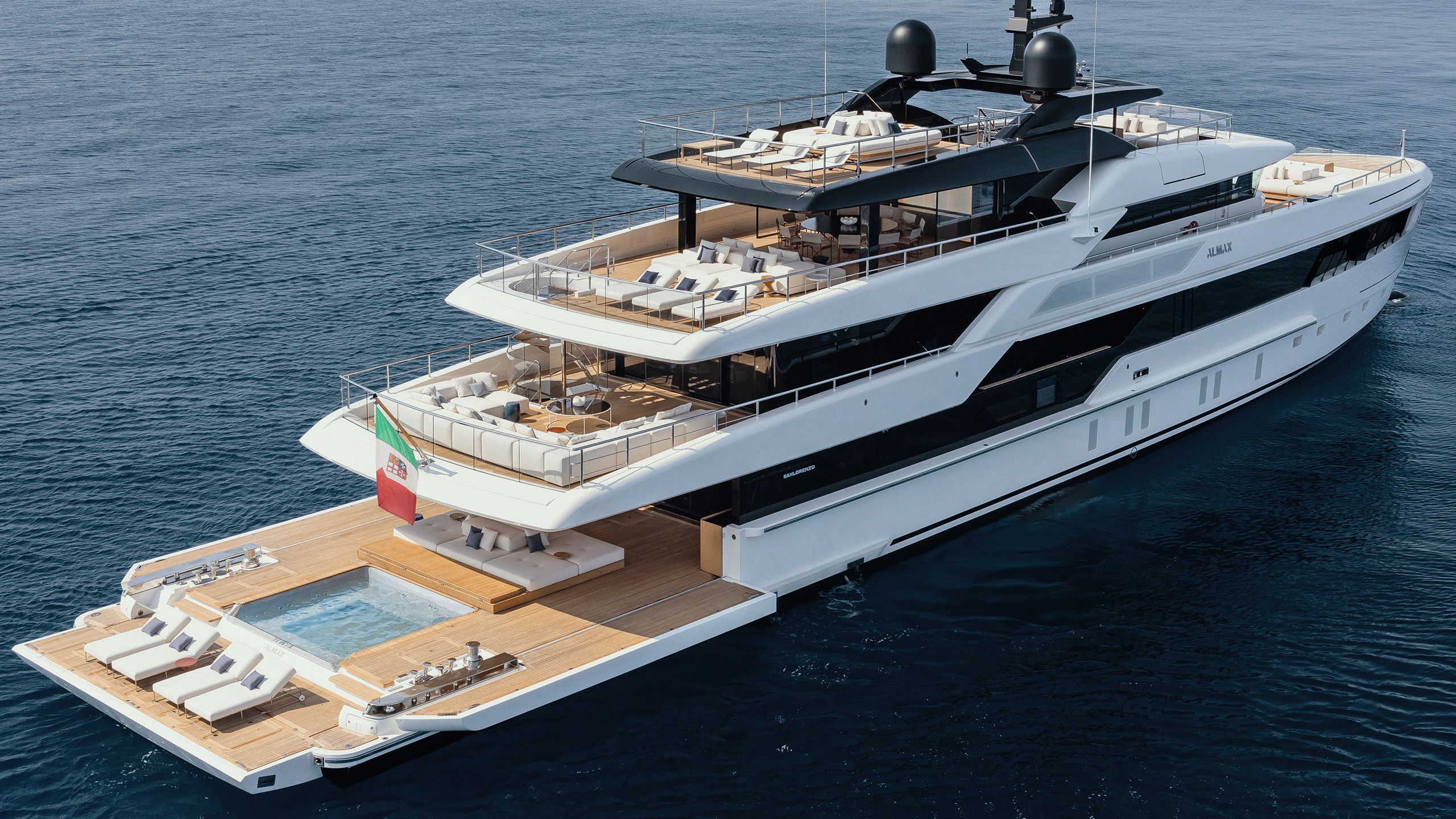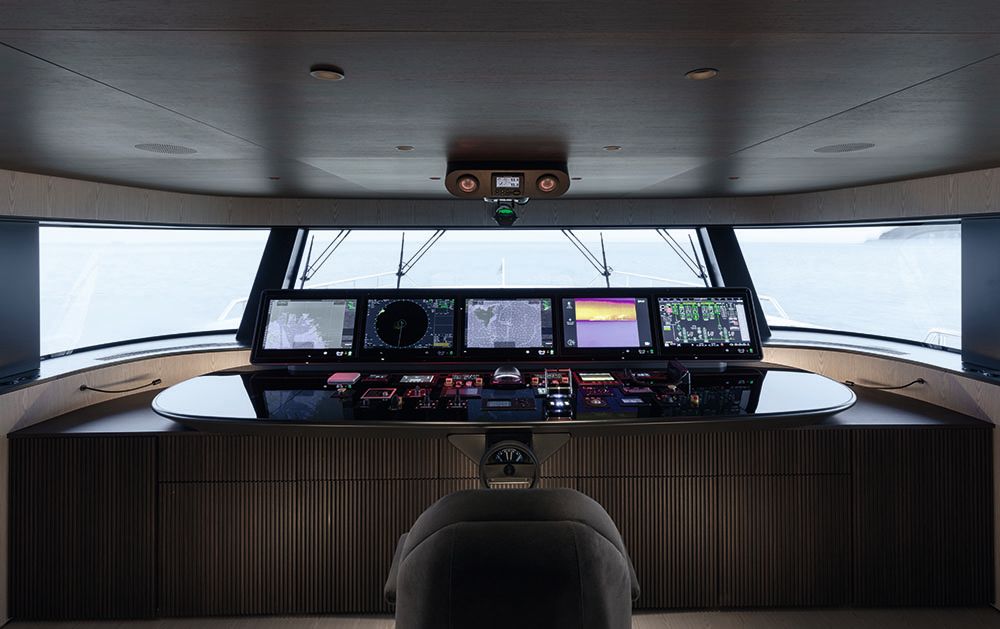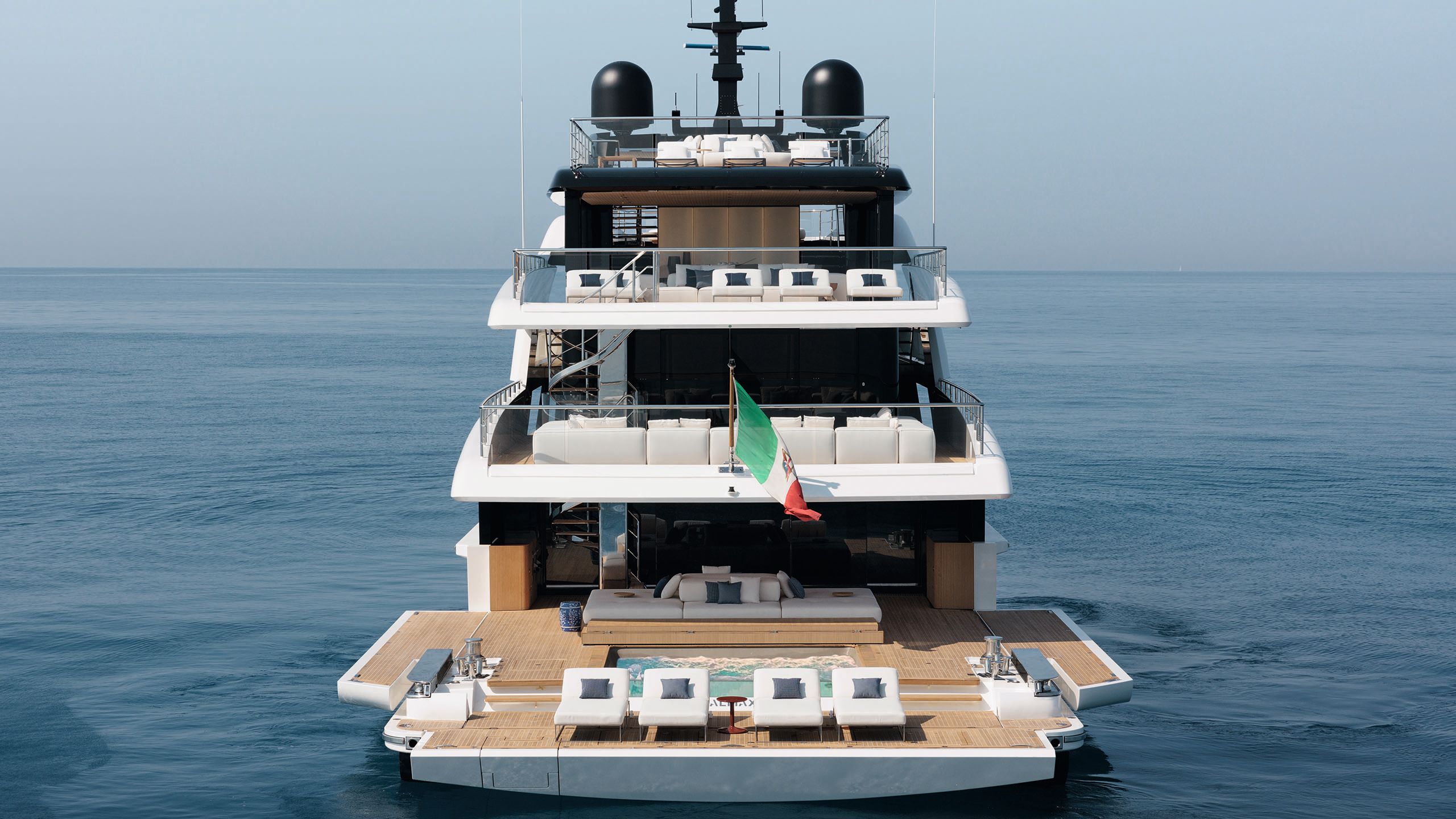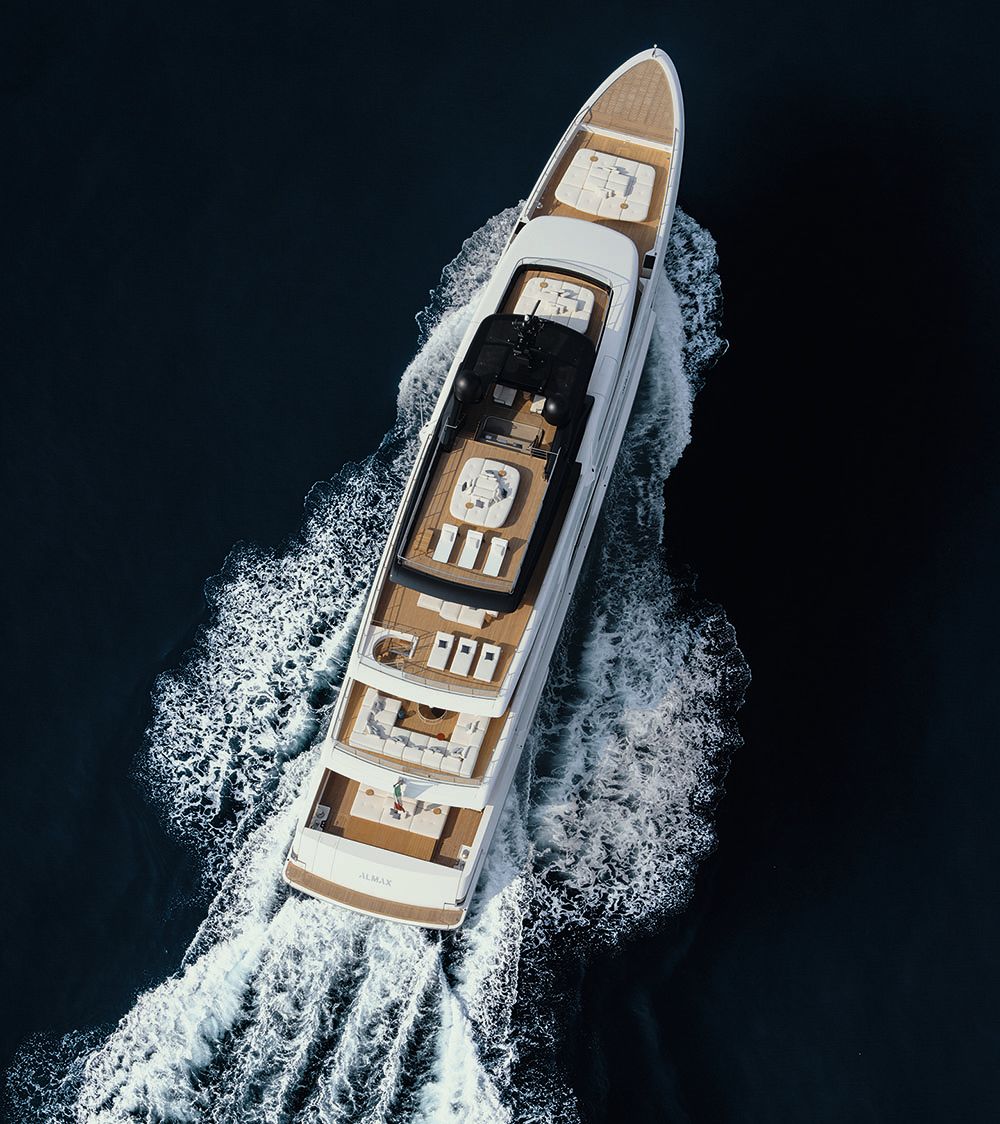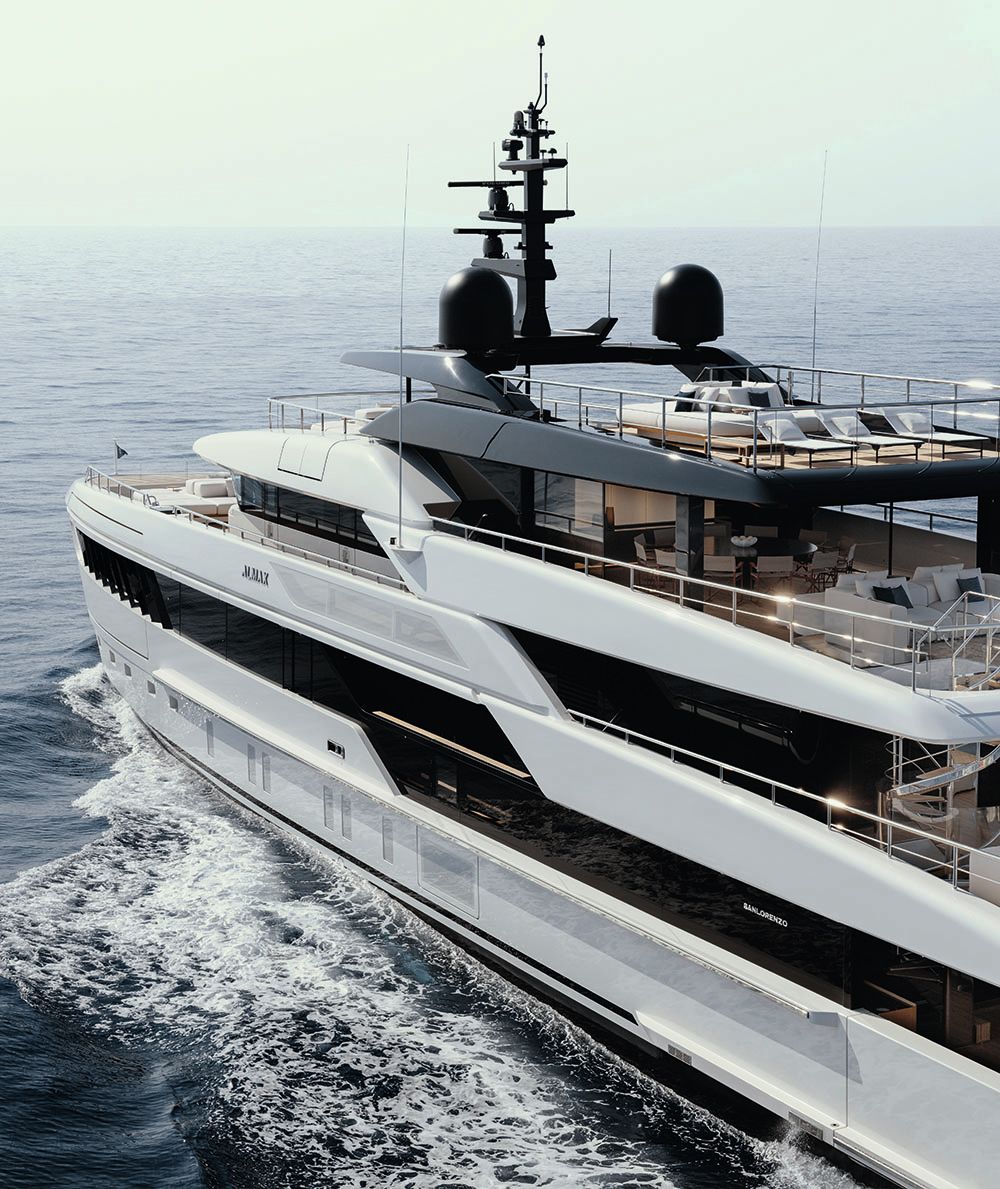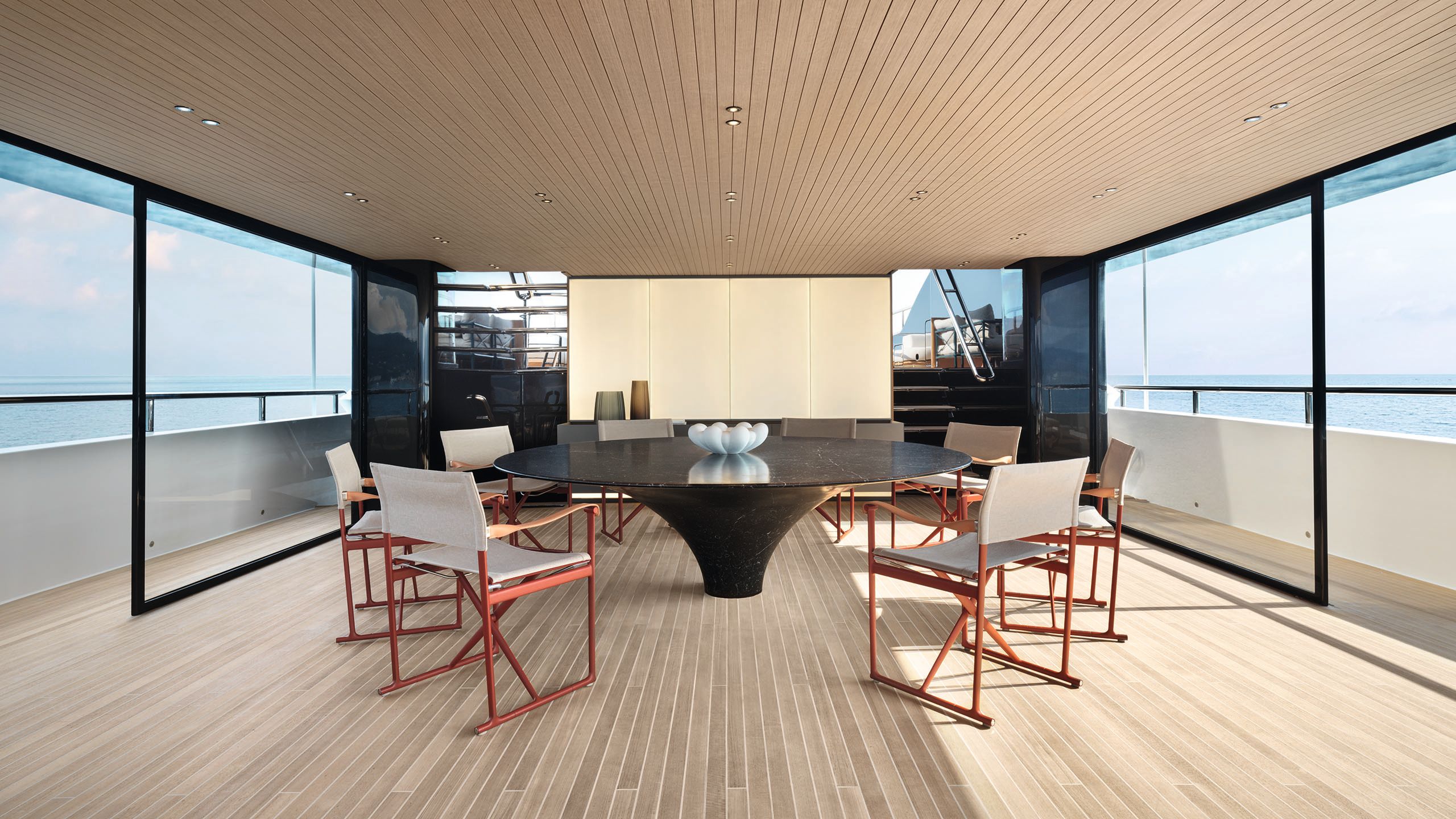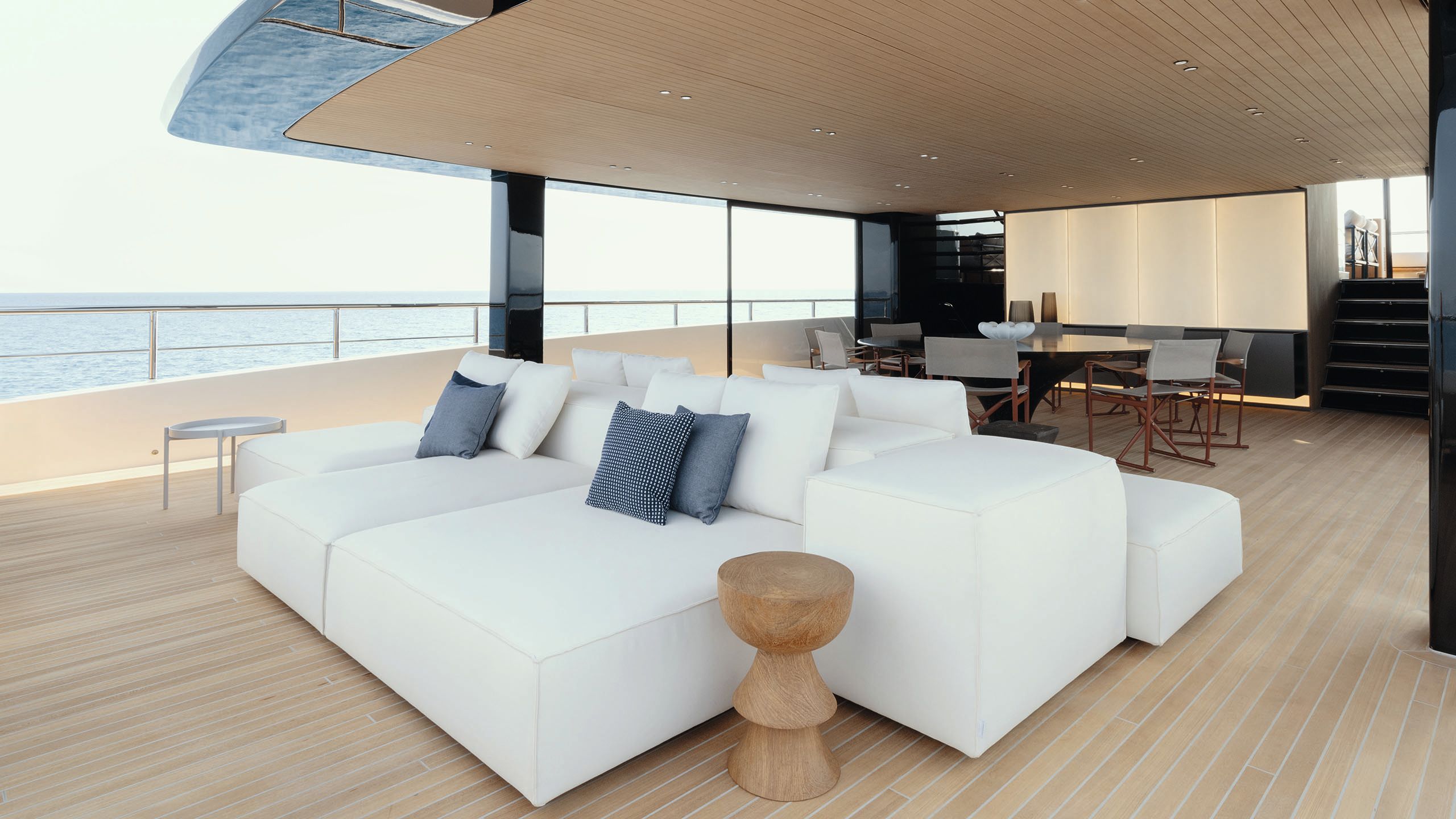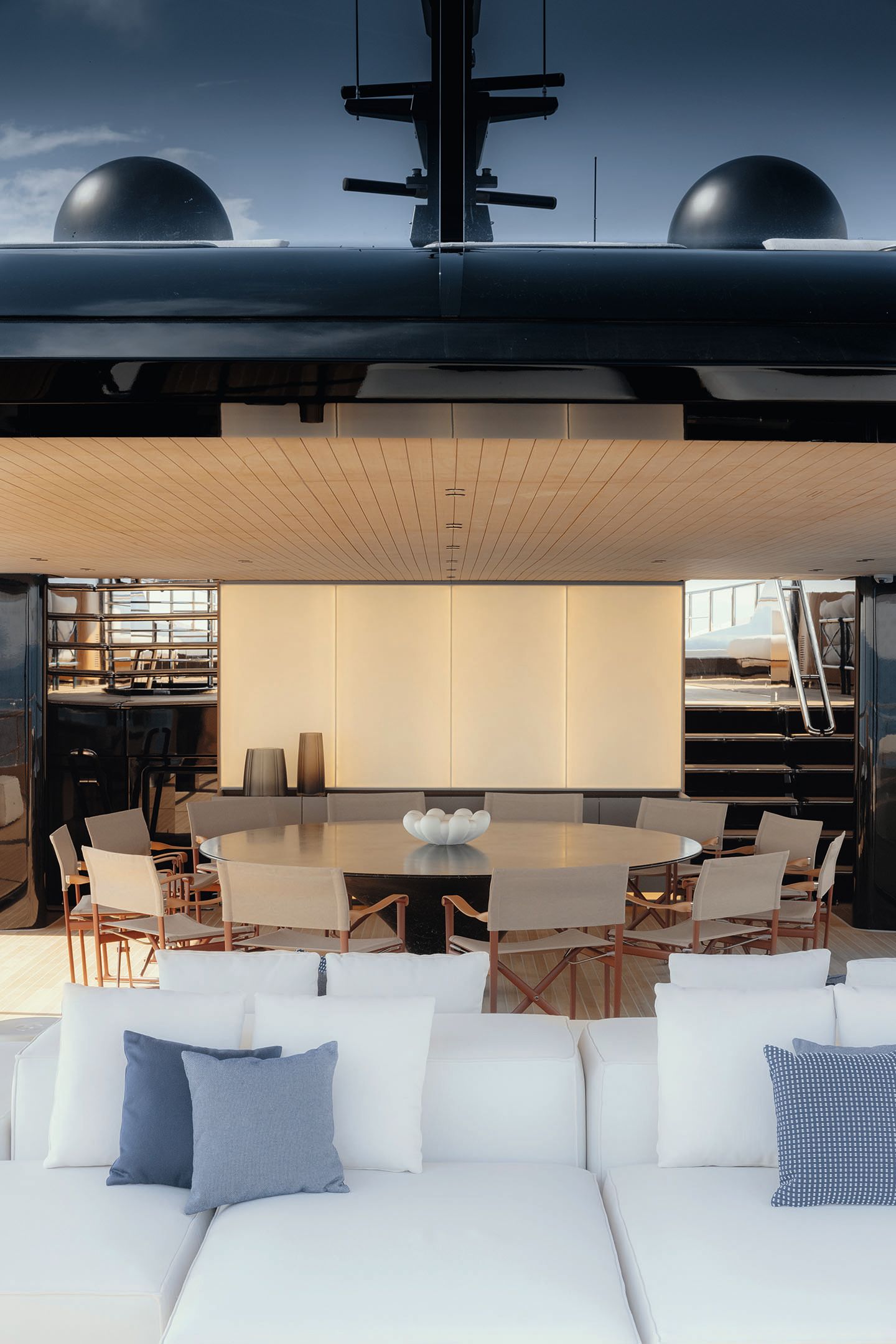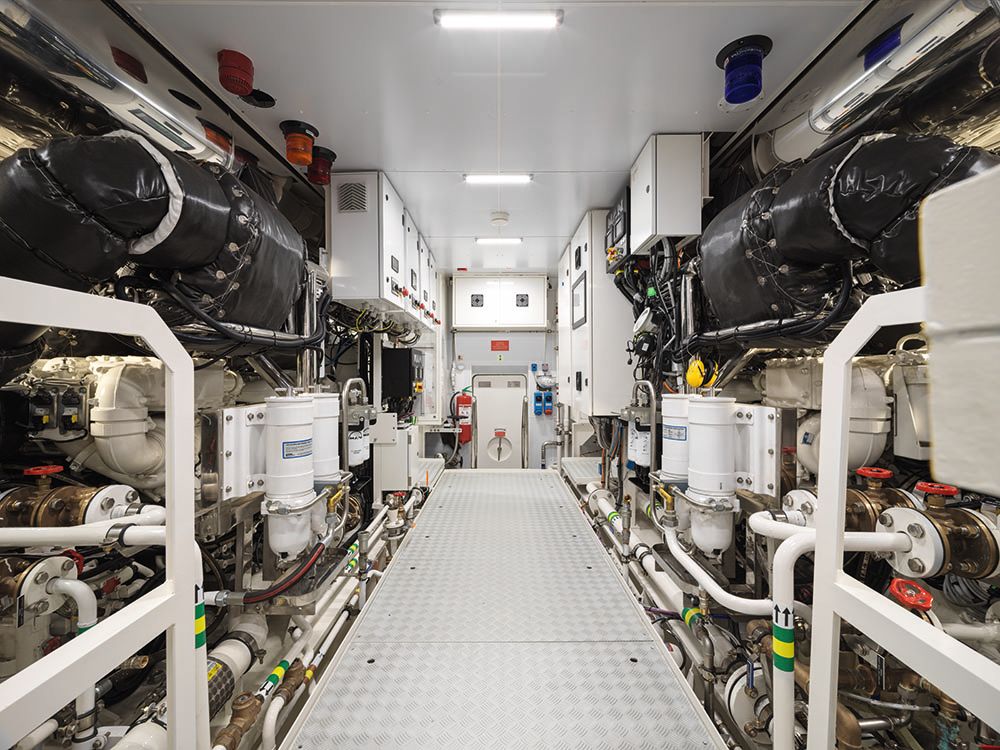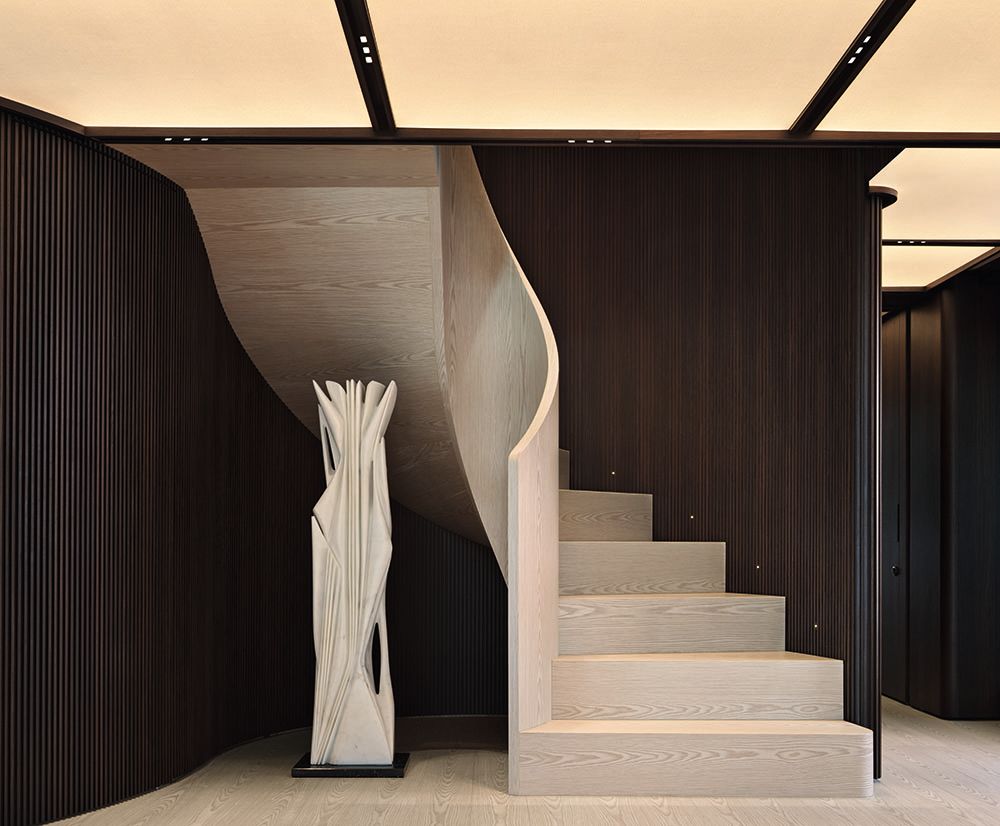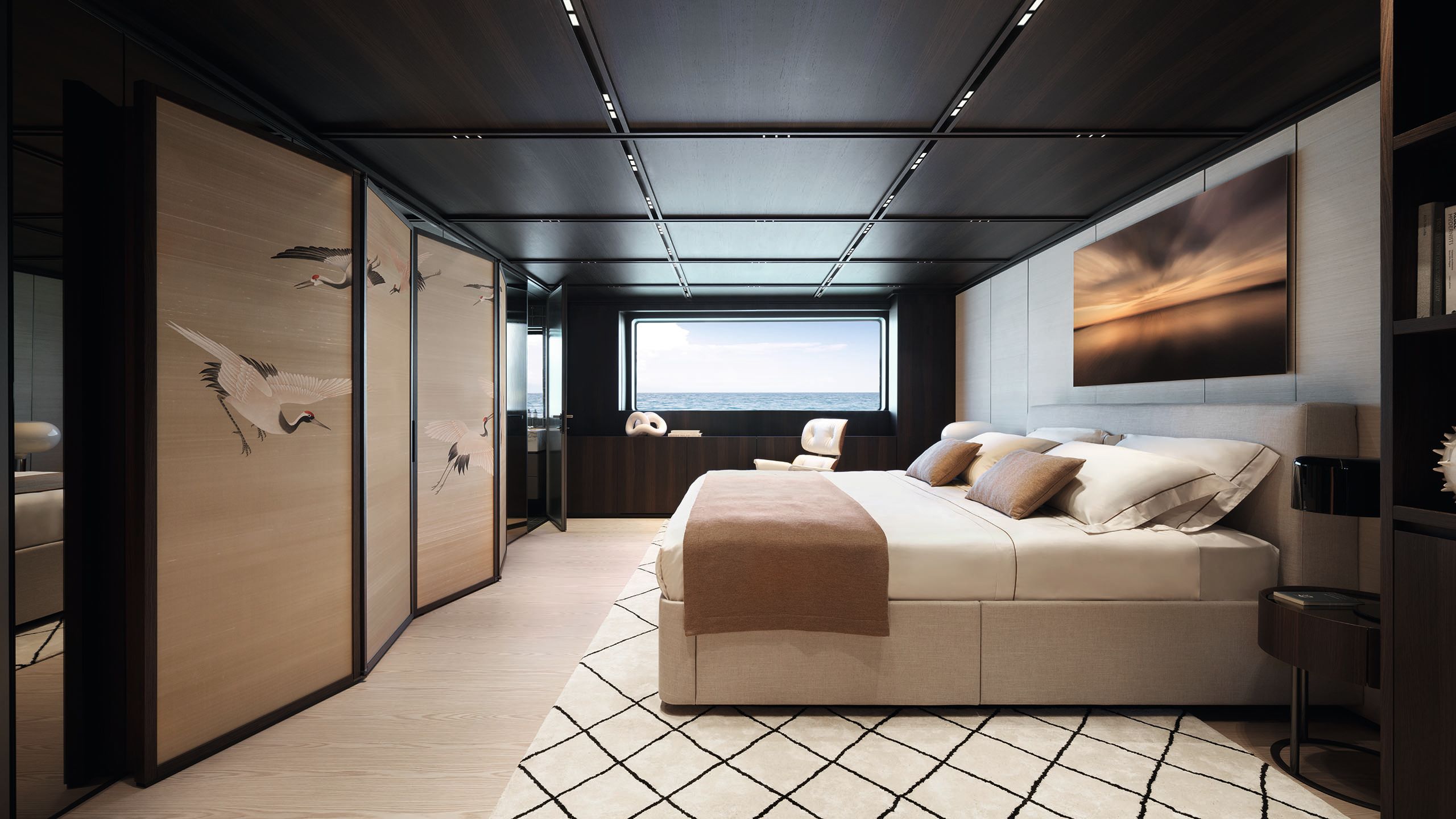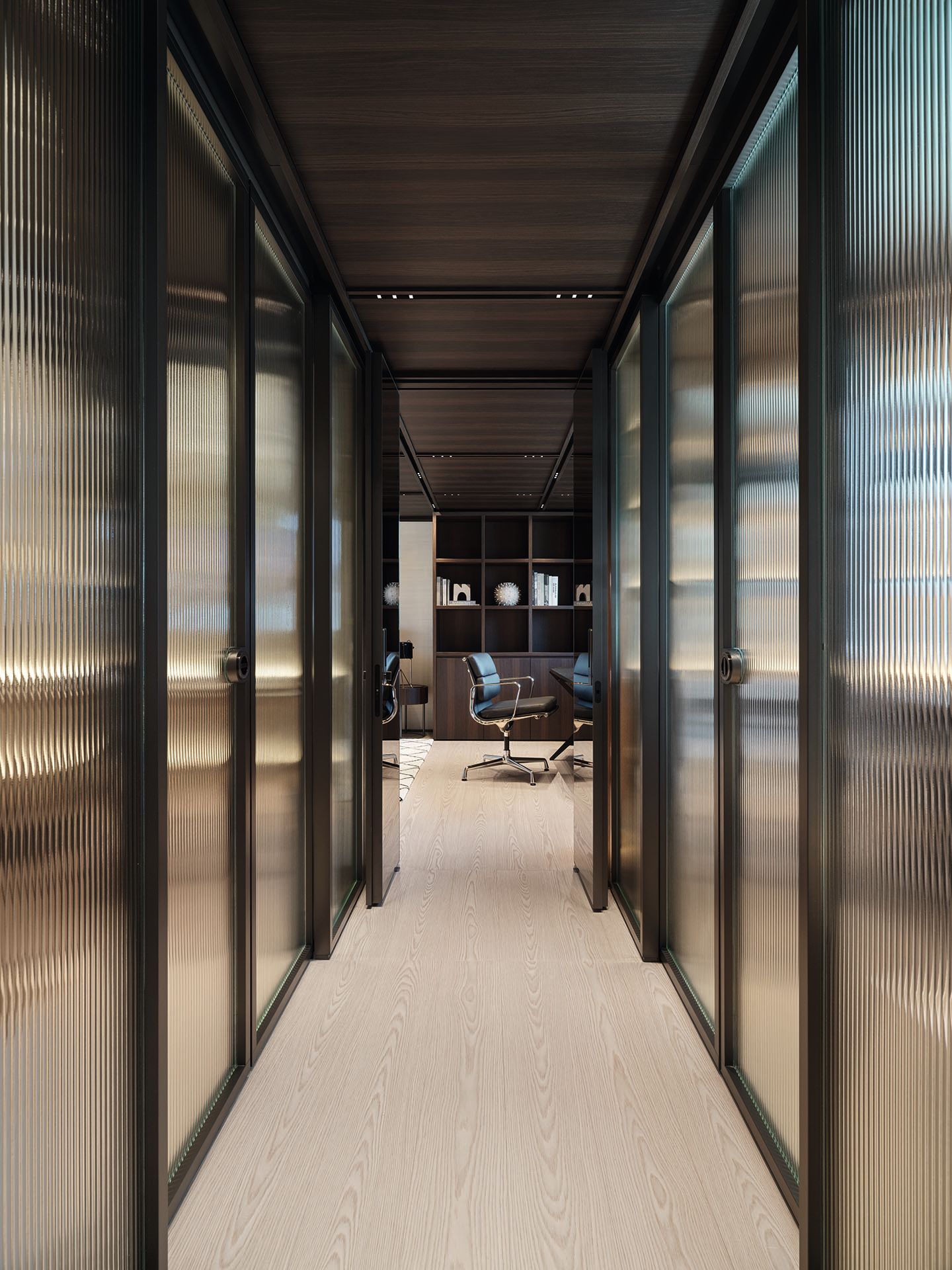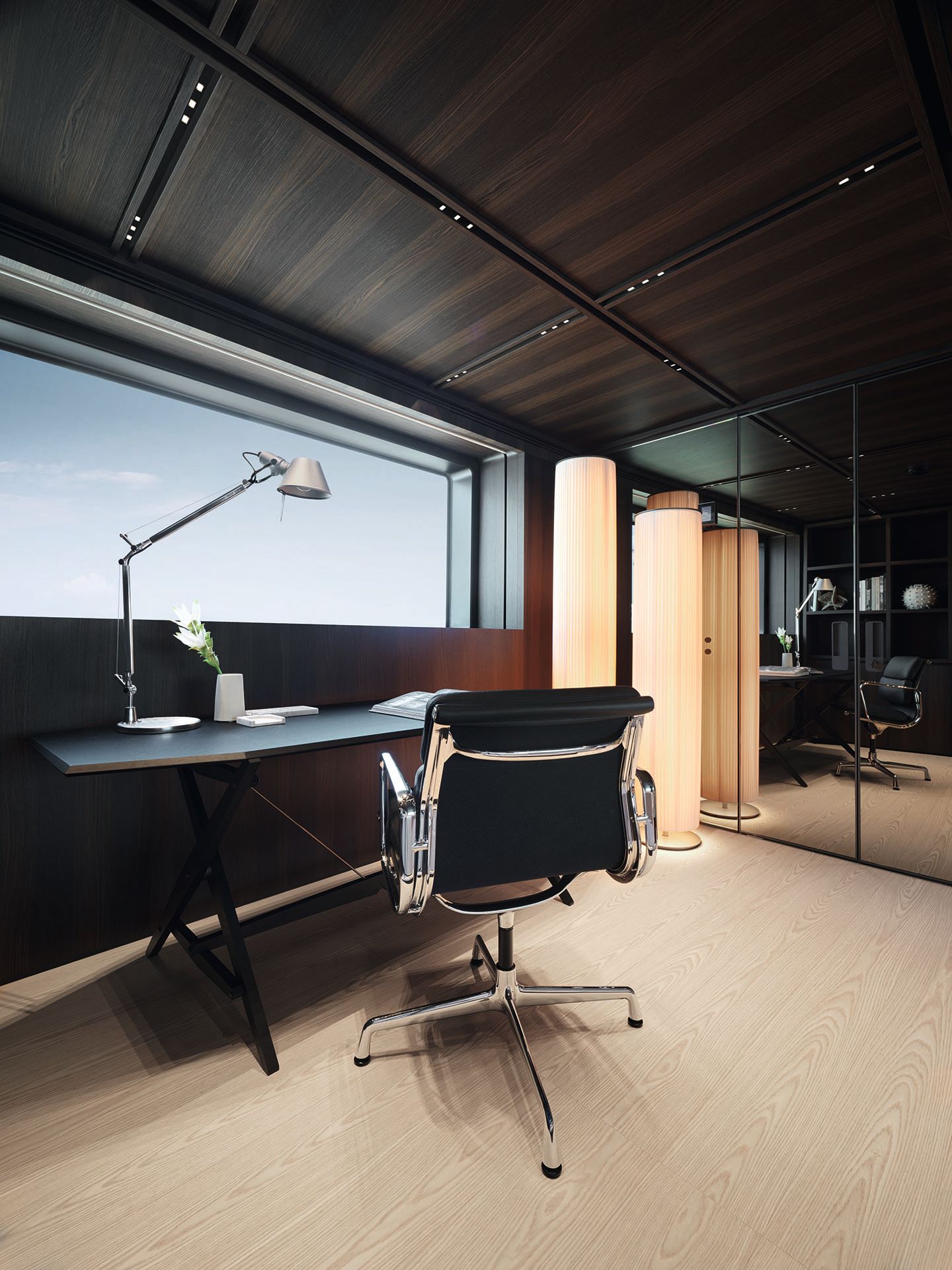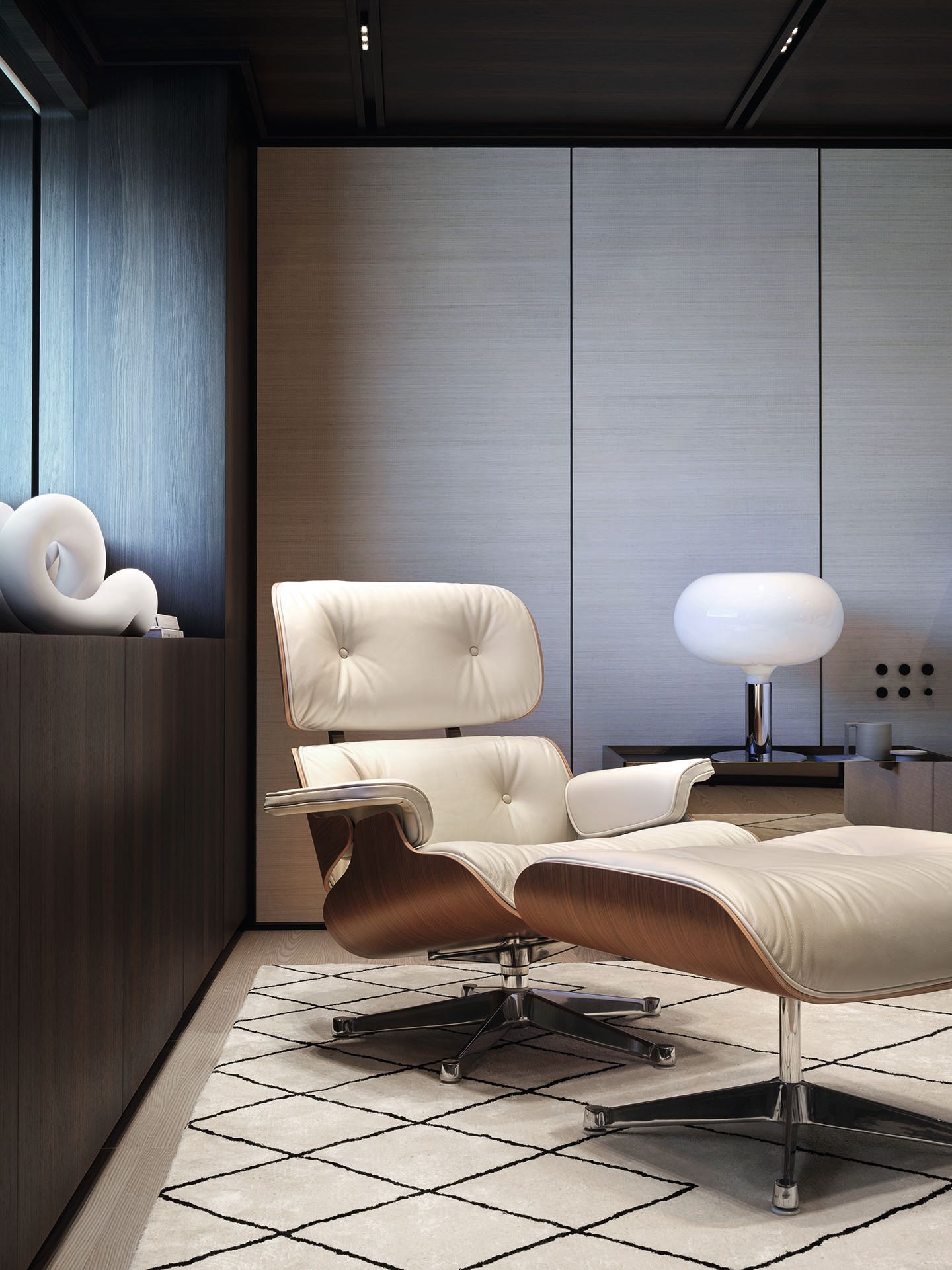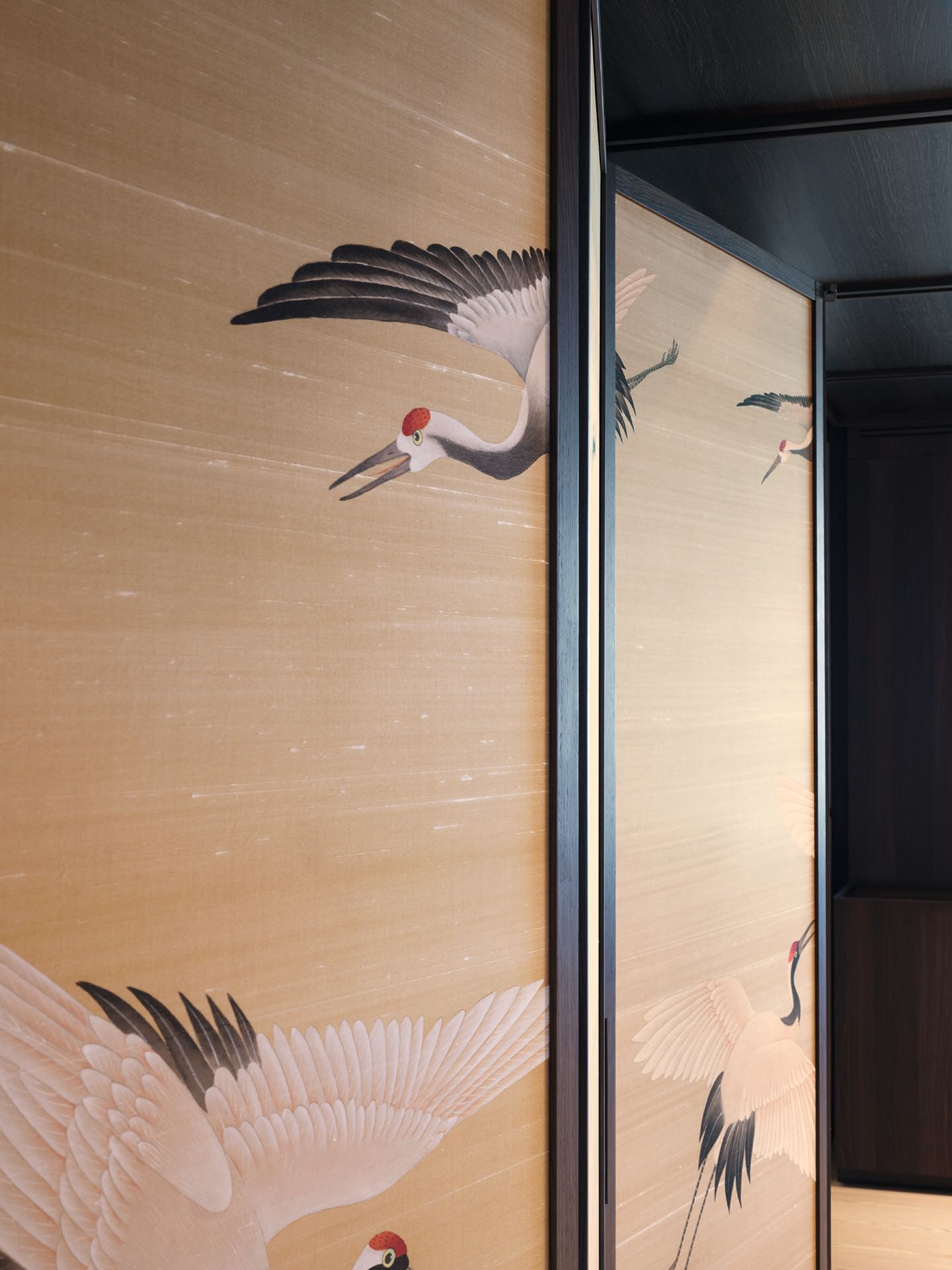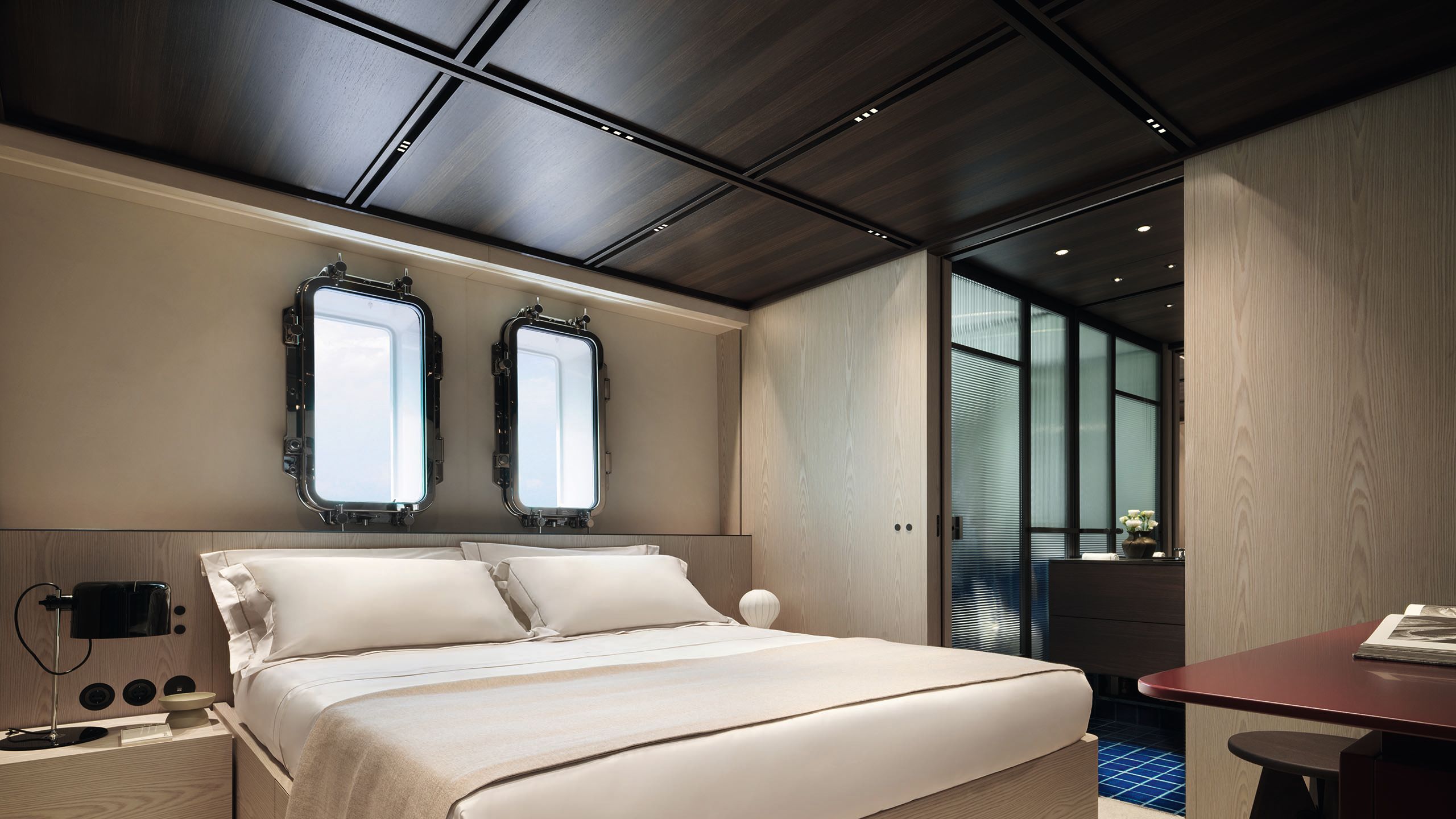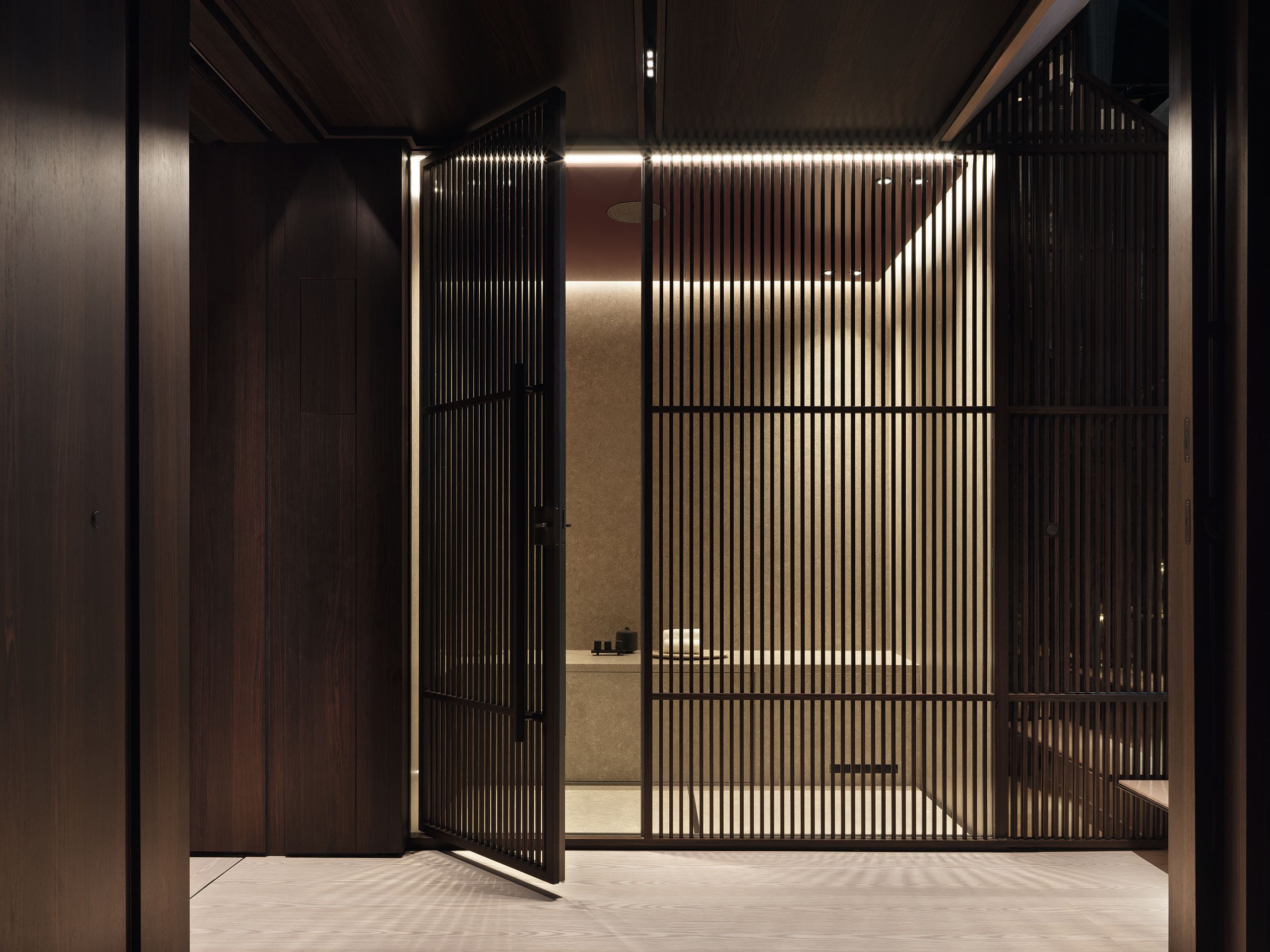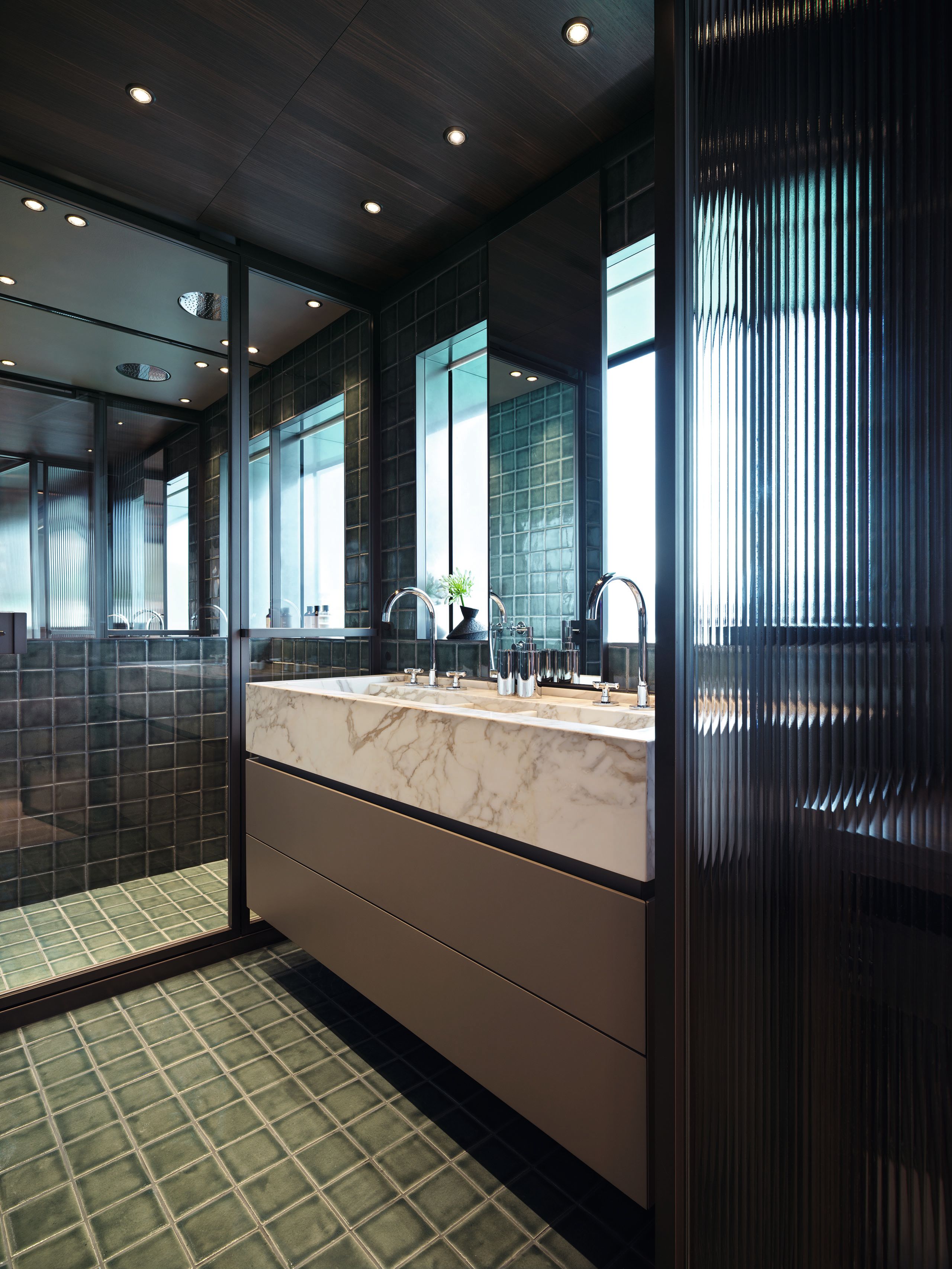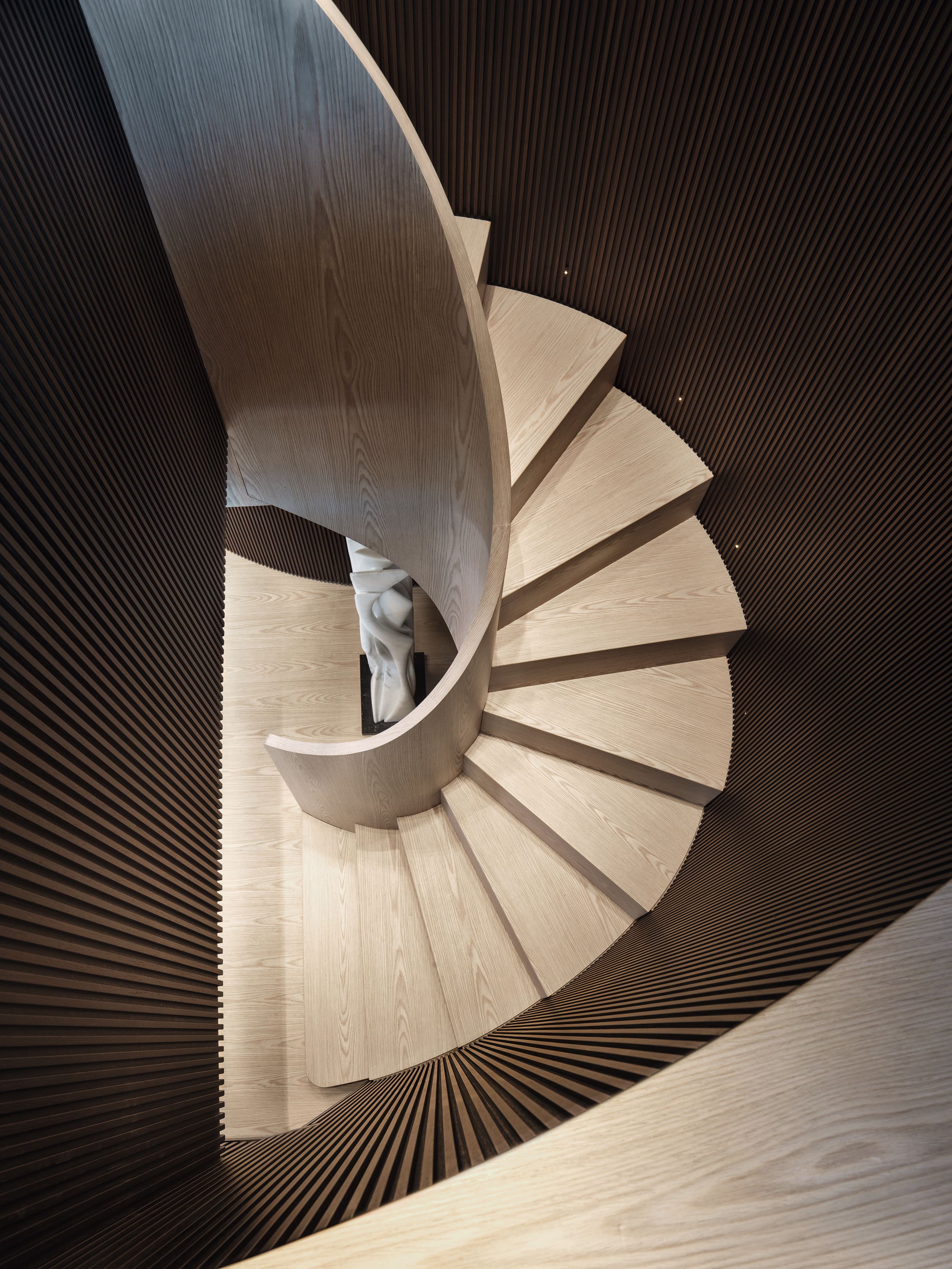FUTURE PERFECT
On board the 50-metre Sanlorenzo superyacht Almax
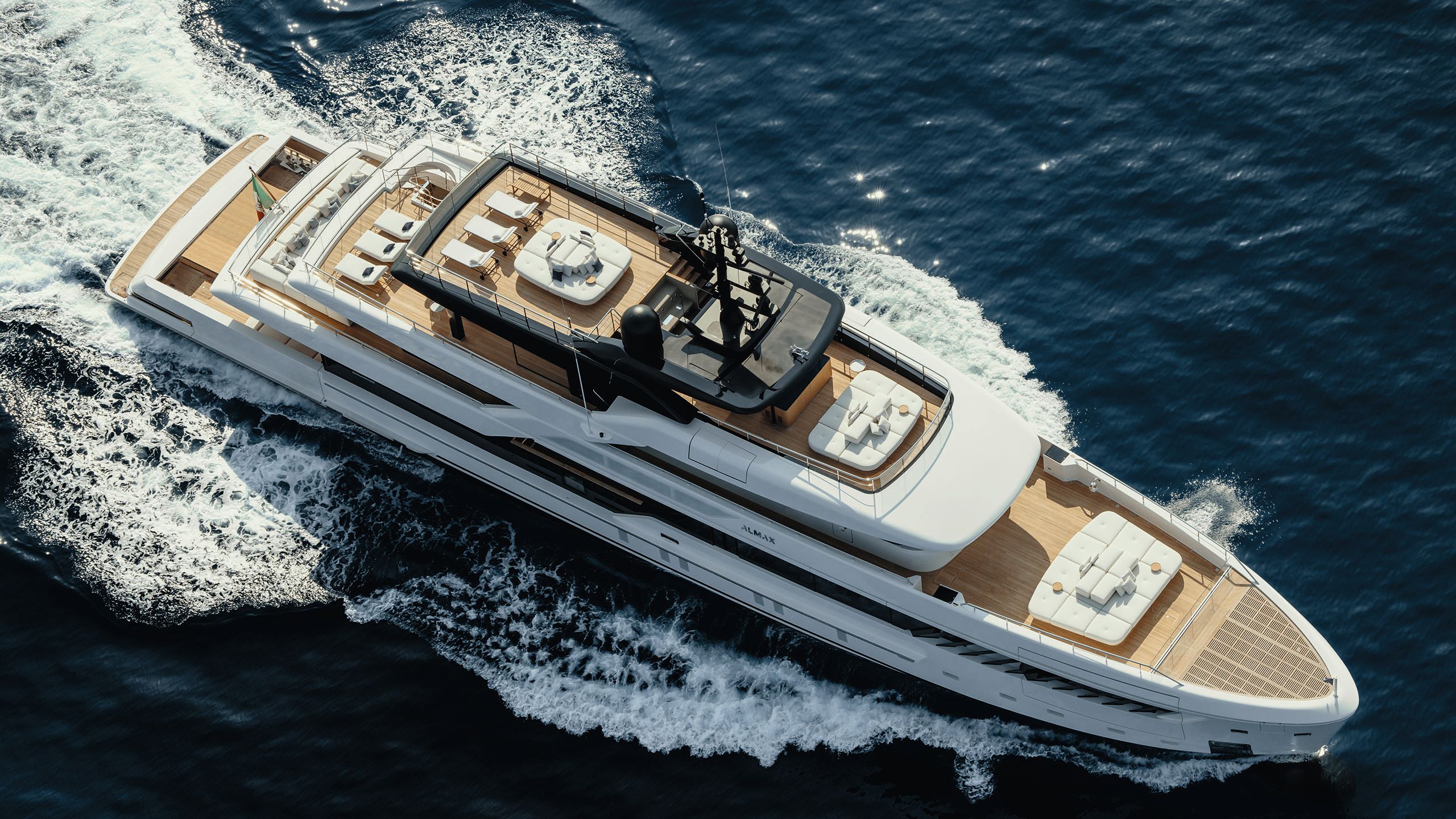
This groundbreaking fuel-cell superyacht is a huge milestone in the future of sustainable boating, but its spliced-up layout and retro design proves there’s more to this 50-metre Sanlorenzo than what’s under the hood. Katia Damborsky gets acquainted with Almax
GUILLAUME PLISSON
Developing new technology in a competitive industry is hard work. Massimo Perotti, CEO of Sanlorenzo and the owner of one of the world’s first fuel-cell superyachts, is tired. We are at the shipyard in his top-floor office, looking out at the packed build sheds, busy docks and workers buzzing around their new builds. In the distance, Perotti’s new 50-metre Almax is shimmering as she glides across the bay in preparation for her photo shoot.
GUILLAUME PLISSON
GUILLAUME PLISSON
She is the culmination of four years of hard work, pioneering research and groundbreaking technology; a yacht with an onboard fuel cell that will store and convert e-methanol (a more eco-conscious alternative to traditional methanol) into electricity to power the yacht’s hotel load. “Everyone is waiting for us to slip on a banana skin,” says Perotti, his eyes on the yacht. “But if you want to do something new, you also have to take risks and be a dreamer.”
GUILLAUME PLISSON
GUILLAUME PLISSON
Perotti definitely dreamt big for Almax. He has built yachts for himself before, to “test” designs before introducing them to the market, but in this case, it was the newness of the fuel-cell technology that convinced him to take on the project for himself.
Together with Siemens, which signed an exclusive agreement with Sanlorenzo to supply the technology for the yacht, Perotti has various obligations in place to monitor and test its performance and iron out any kinks over the coming years. After that, Almax will be brought to the market.
GUILLAUME PLISSON
GUILLAUME PLISSON
The introduction of this new technology came with compromises. Things like the en suite in the owner’s cabin – which is exceedingly small for a 50-metre because 18 square metres from this area had to be sacrificed for the fuel cell in the bow – and the capacity of the fuel cell itself, which supplies a maximum of 100kW. But Perotti has another food-themed anecdote for me: “Slice the salami before you swallow it.” Essentially, one step at a time.
GUILLAUME PLISSON
GUILLAUME PLISSON
All eyes are certainly trained on the yard and its yacht. There haven’t been any “banana skin” moments yet, but then, building Almax was only half the battle. When the keel was laid, there were no parameters that could be followed and no regulations in place to provide a framework. As Siemens was developing the project, regulatory body Lloyd’s was working in parallel to conjure up guidelines in response to each new development.
The introduction of this new technology came with compromises. Things like the en suite in the owner’s cabin – which is exceedingly small for a 50-metre because 18 square metres from this area had to be sacrificed for the fuel cell in the bow – and the capacity of the fuel cell itself, which supplies a maximum of 100kW. But Perotti has another food-themed anecdote for me: “Slice the salami before you swallow it.” Essentially, one step at a time.
GUILLAUME PLISSONIt’s not obvious from the exterior design, but each deck from lower to sun is split level. This gives the unusual general arrangement nine levels in total, including the tank deck
GUILLAUME PLISSONIt’s not obvious from the exterior design, but each deck from lower to sun is split level. This gives the unusual general arrangement nine levels in total, including the tank deck
All eyes are certainly trained on the yard and its yacht. There haven’t been any “banana skin” moments yet, but then, building Almax was only half the battle.
When the keel was laid, there were no parameters that could be followed and no regulations in place to provide a framework. As Siemens was developing the project, regulatory body Lloyd’s was working in parallel to conjure up guidelines in response to each new development.
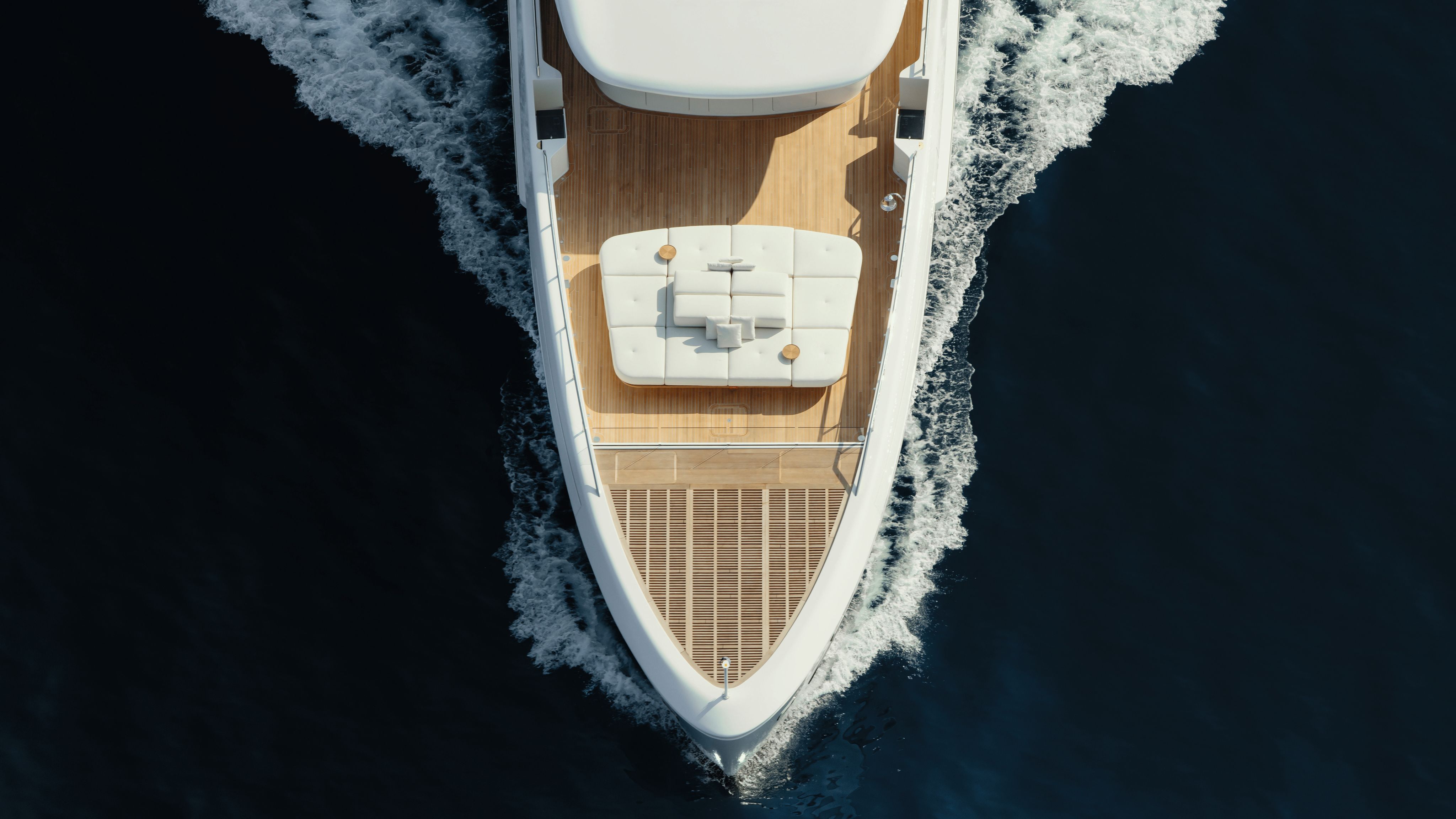
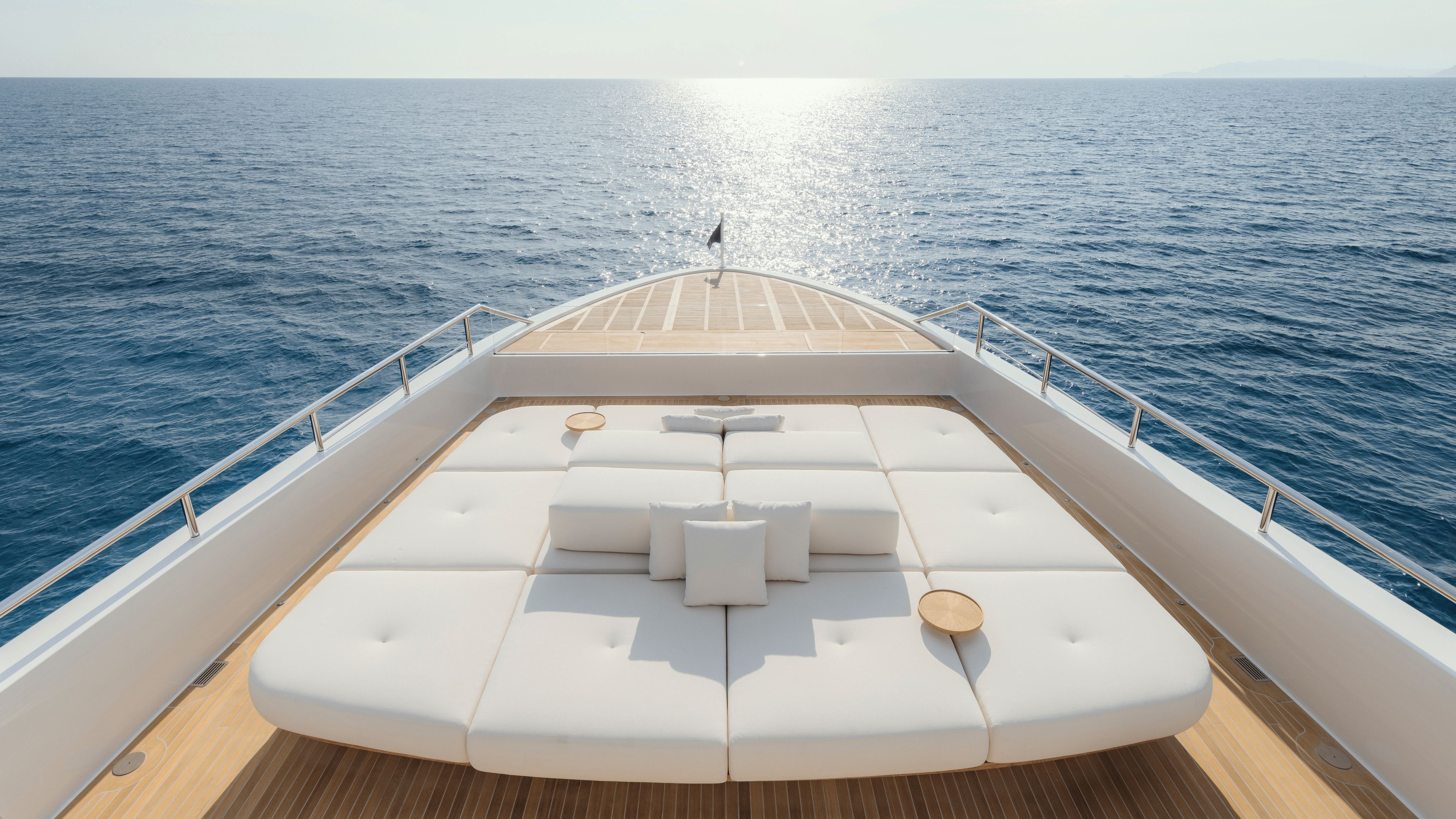
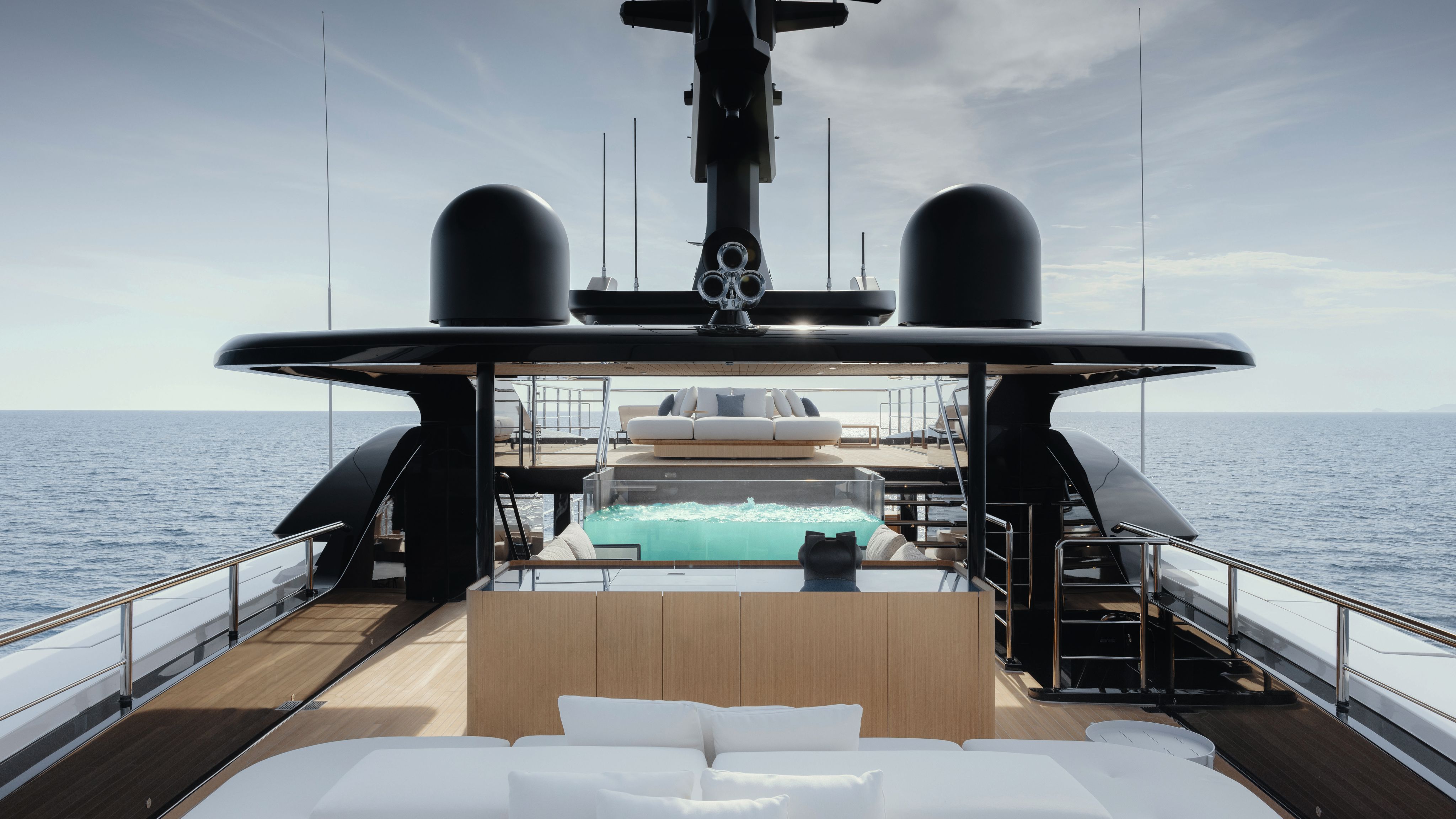
The big challenge, of course, will be the feasibility of methanol. Without regulations, distribution and some kind of incentive to make methanol more cost-effective (a litre of e-methanol provides almost a third of the power as the same quantity of diesel, and e-methanol is about three times more expensive than regular methanol), Almax and any other methanol-driven boats will remain “nice prototypes” rather than practical solutions.
GUILLAUME PLISSON It’s not obvious from the exterior design, but each deck from lower to sun is split level. This gives the unusual general arrangement nine levels in total, including the tank deck
GUILLAUME PLISSON It’s not obvious from the exterior design, but each deck from lower to sun is split level. This gives the unusual general arrangement nine levels in total, including the tank deck
The big challenge, of course, will be the feasibility of methanol. Without regulations, distribution and some kind of incentive to make methanol more cost-effective (a litre of e-methanol provides almost a third of the power as the same quantity of diesel, and e-methanol is about three times more expensive than regular methanol), Almax and any other methanol-driven boats will remain “nice prototypes” rather than practical solutions.
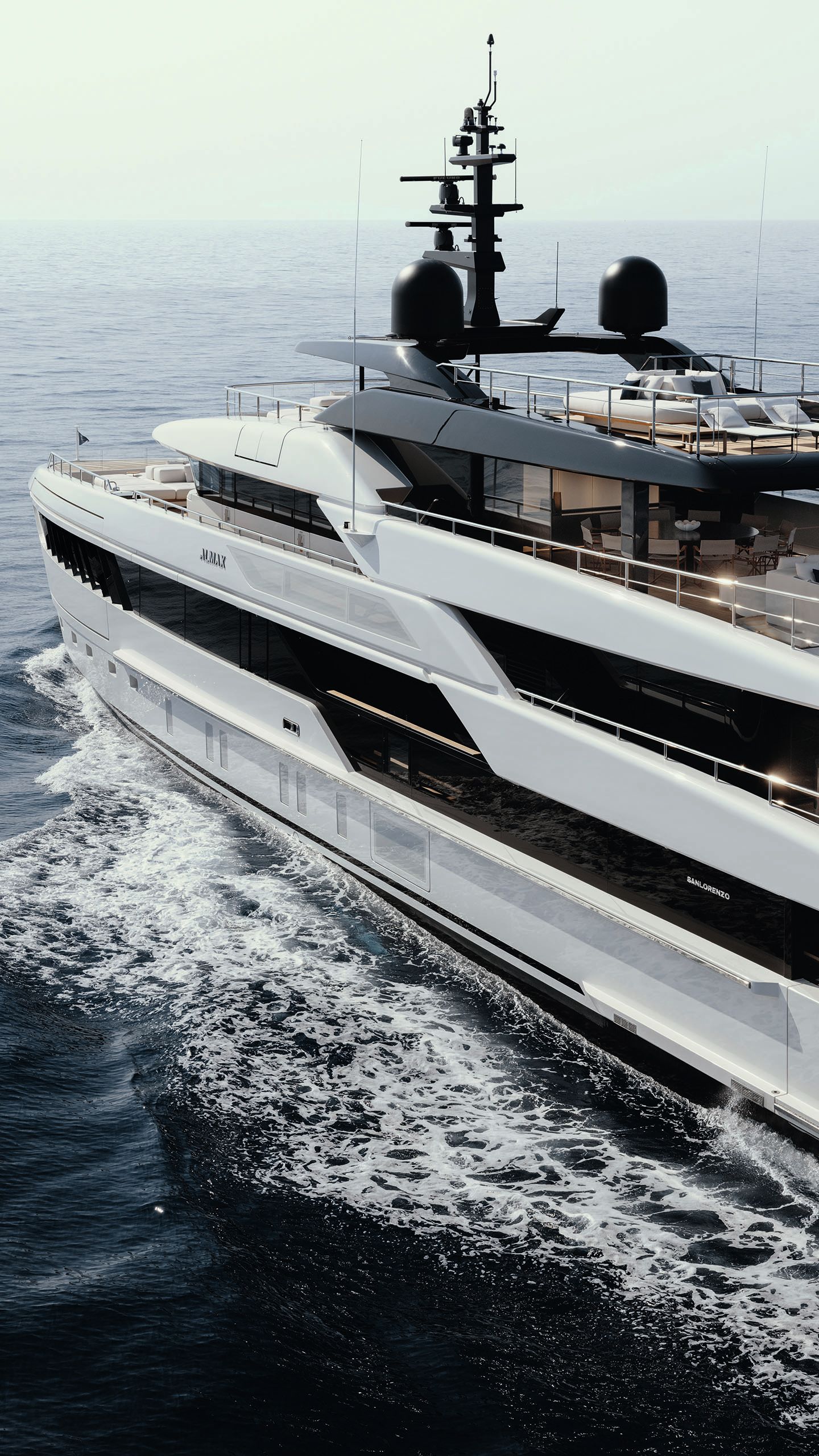
“But consider people at the beginning of the 20th century were getting around on horses, there were no roads, no fuel stations, no fuel plants,” points out Perotti. One slice of salami at a time.
Is he confident in the project? It’s hard to tell. The exclusivity agreement between Sanlorenzo and Siemens will expire at the end of 2024, and it won’t be until 2025 that the fuel-cell-powered model could be brought to market. If methanol continues to find its footing in the world of commercial shipping, then by 2027 or 2028 – at the earliest – methanol should be widespread enough to make cruising feasible.
GIONATA XERRAThe upper aft deck offers outdoor dining in a protected environment. The lit panels forward are covered in a thin layer of linen-like material that creates a soft-focus glow
GIONATA XERRAThe upper aft deck offers outdoor dining in a protected environment. The lit panels forward are covered in a thin layer of linen-like material that creates a soft-focus glow
While the first 50Steel unit is remarkable for its technology, the line will be available without the fuel cell too, and the design of the yacht marks a new chapter in and of itself.
“You really appreciate the relationship between you and the surrounding nature, which on a 50-metre you don’t always feel”
“Evolution” is the best word for it, since it’s evident that Zuccon International Project and Lissoni & Partners – the minds behind exterior and interior design, respectively – drew on past models for the 50Steel. The deck design was inspired by the SP110 and 44Alloy, boats that have earned Bernardo Zuccon a reputation for being “the split-level guy”.
GUILLAUME PLISSON
GUILLAUME PLISSON
GUILLAUME PLISSON
GUILLAUME PLISSON
Zuccon took that reputation and ran with it for the 50Steel, chopping up the five decks to create nine levels in total, with a beautifully bizarre layout that staggers and cascades to create a fun combination of nooks and unexpected open areas.
Aft of a mezzanine between the beach lounge and main saloon is an amidships area where overhead height soars to almost four metres and the space is flanked by tall windows.
GIONATA XERRAThe dining saloon features the same lit panels as the upper aft deck. The “Grasshopper” table was designed by Piero Lissoni as a balance of industry meets art
GIONATA XERRAThe dining saloon features the same lit panels as the upper aft deck. The “Grasshopper” table was designed by Piero Lissoni as a balance of industry meets art
“From the very beginning, we decided to use that area for the dining table,” says Zuccon. “You really appreciate the relationship between you and the surrounding nature, [which] on a 50-metre [you don’t always feel].”
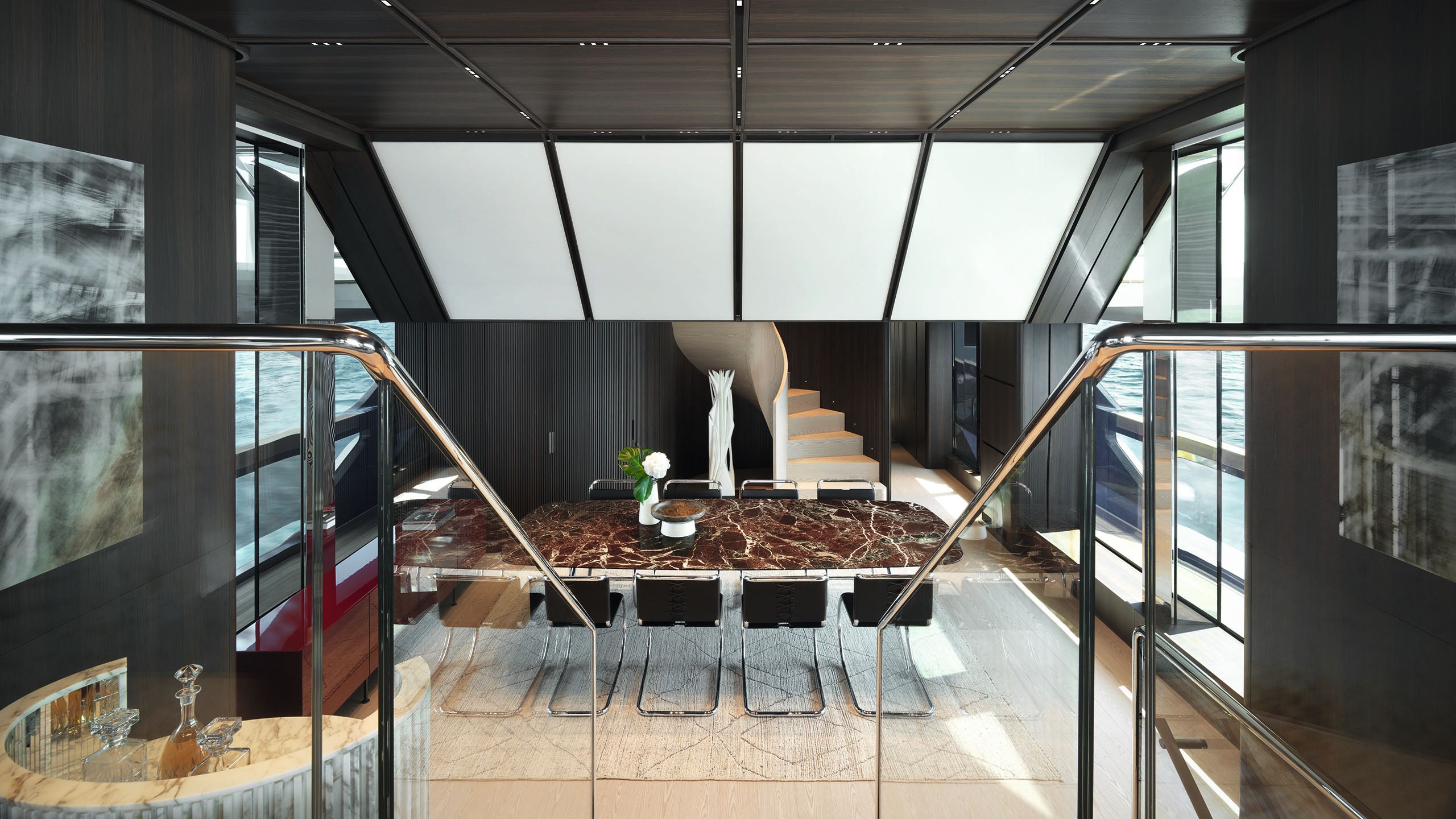
GIONATA XERRA
GIONATA XERRA
Other clever deviations can be seen in the beach club space, which is linked to a sauna, gym and the guest accommodation, meaning that once you get out of the water, you don’t need to traipse through the yacht to get back to your cabin (unless you’re the owner).
This set-up is possible thanks to the Hidden Engine Room (known as “HER” by the yard), which boils down all the engine room components into a single level space that is tucked under the beach club saloon. For Zuccon, the extra space “was like a Christmas gift”.
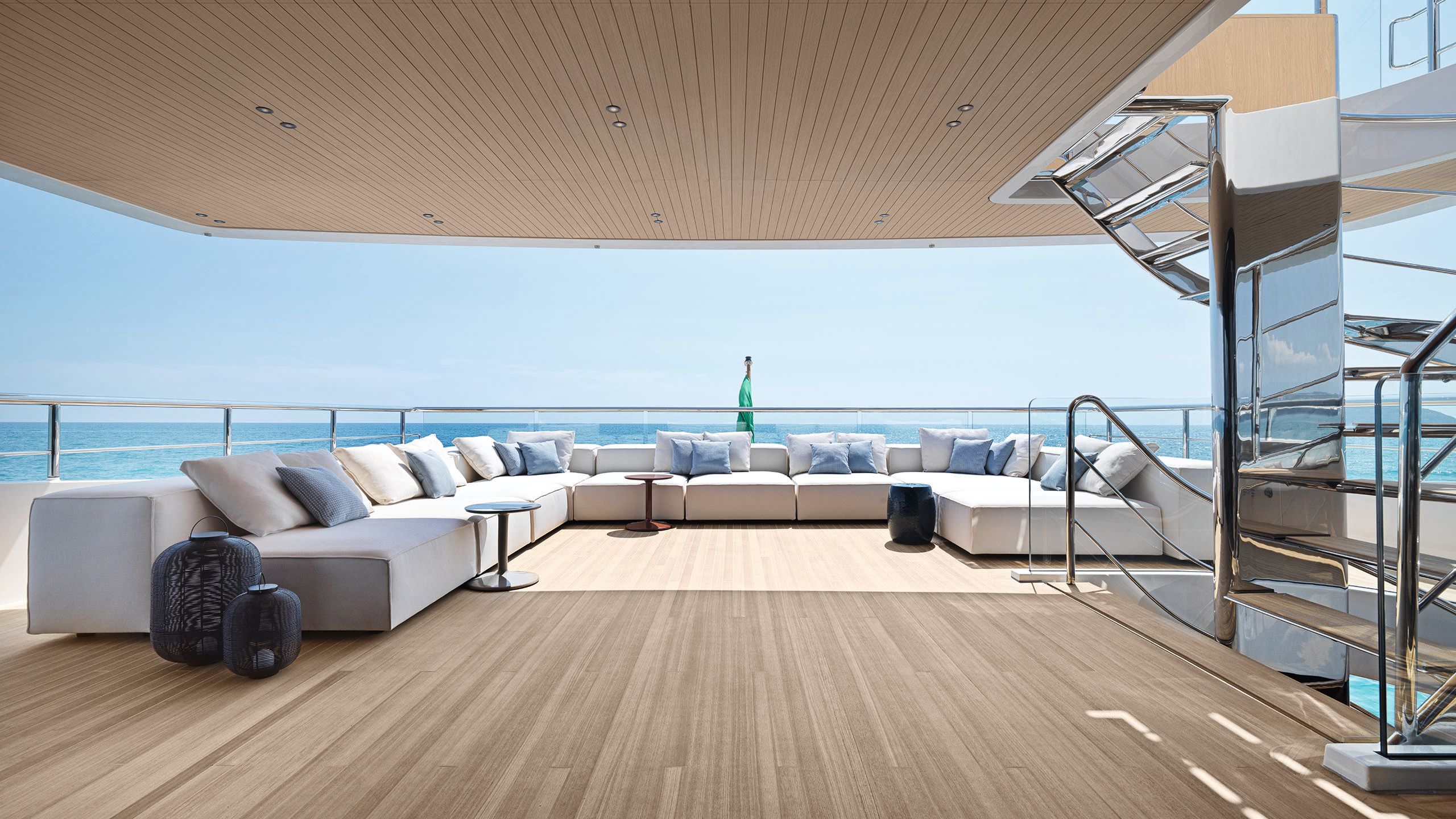
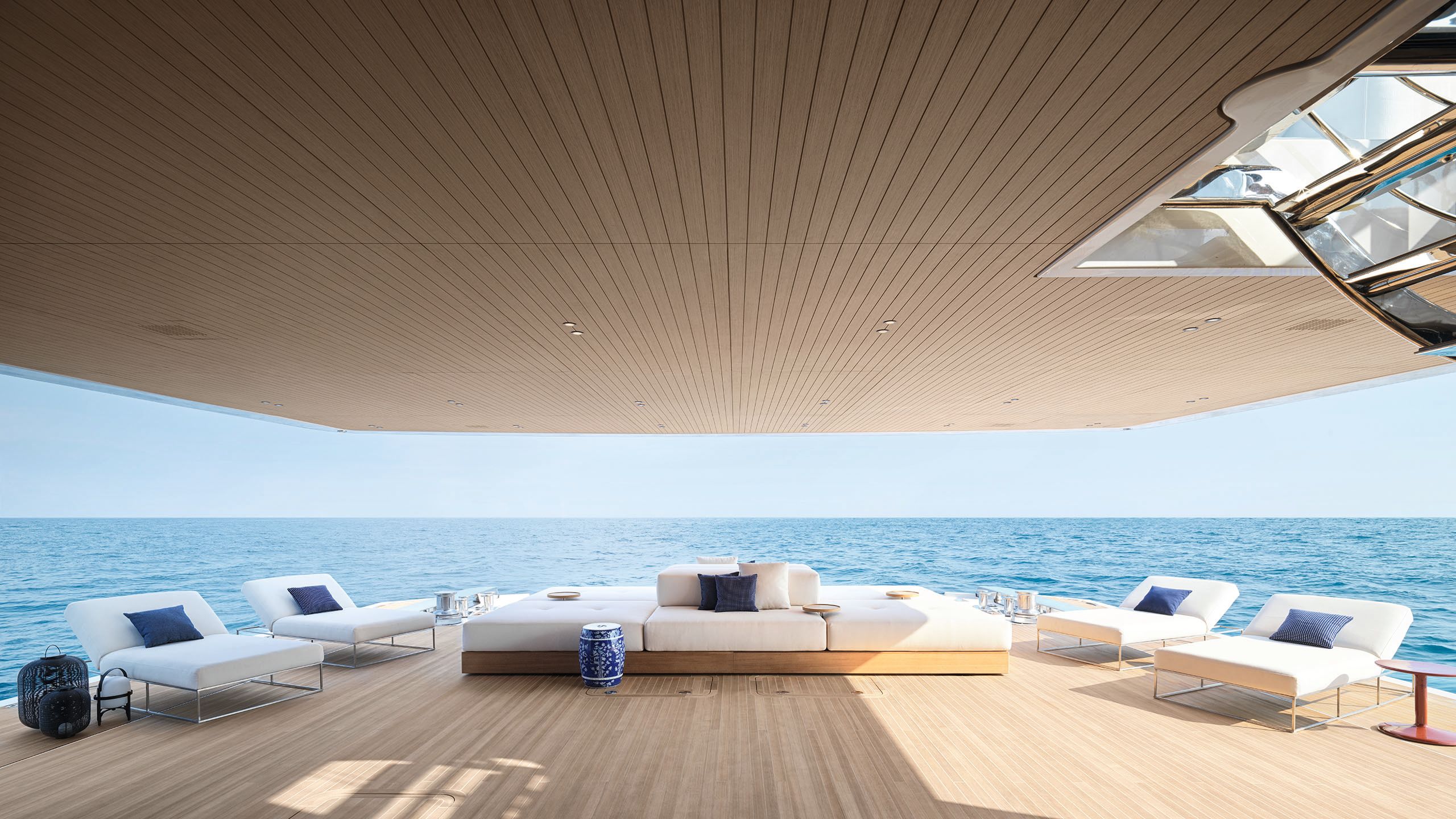
The compact footprint of the engine room means that engines and generators are slightly smaller and therefore deliver less energy – and that is something that Sanlorenzo is trying to push forward in the marketplace.
“Imagine you have a car with 280 horsepower,” explains Paolo Bertetti, Sanlorenzo’s vice president of technical and R&D. “Maximum speed is 240 kilometres per hour. But when do we use all the power? Never. Once, maybe. The rest of the time you’re adhering to speed limits.”
INSIDE THE CELL
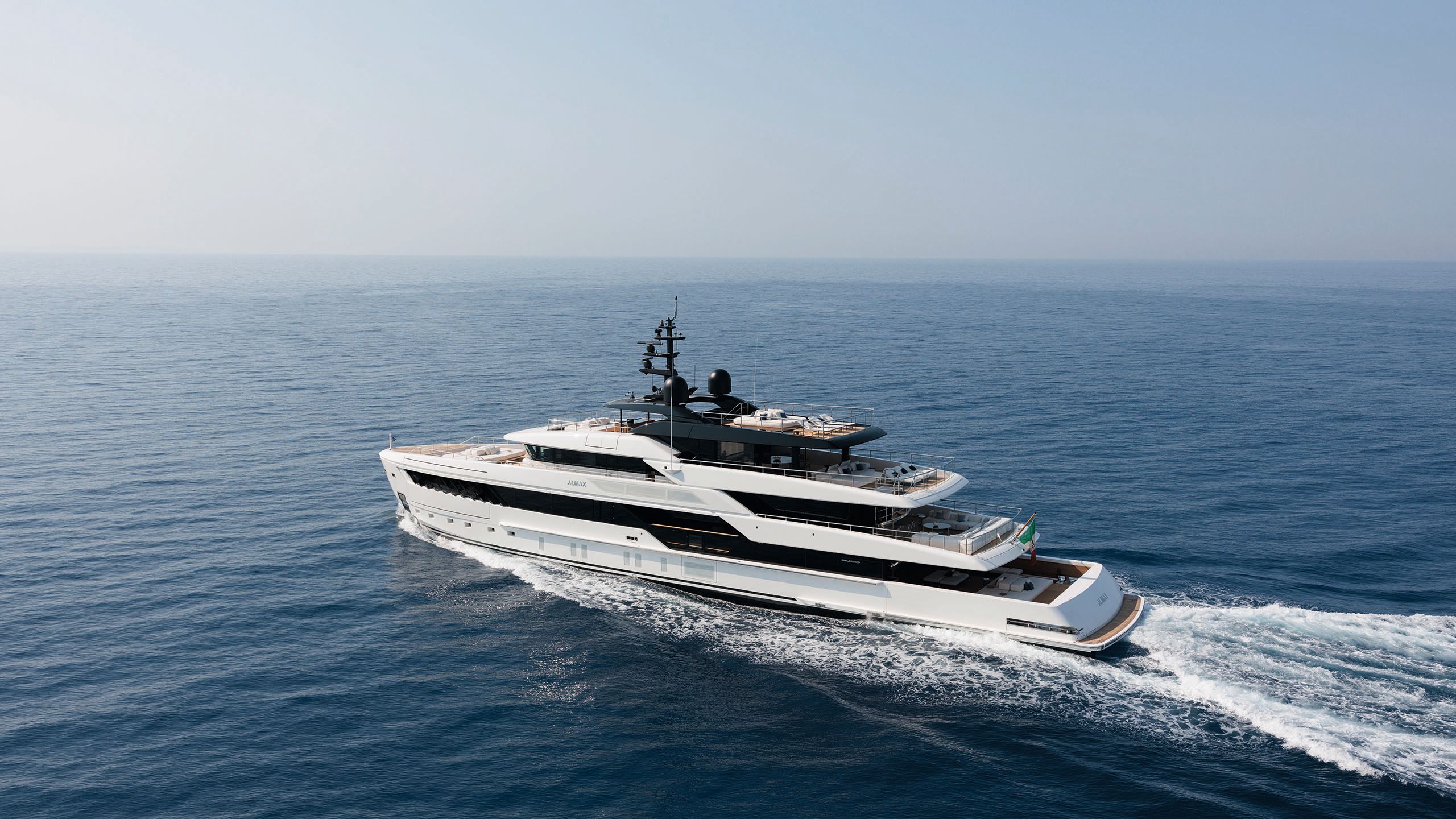
How does the fuel-cell powered 50Steel work? Propulsion will be powered by diesel. Hotel load will harness electricity. The fuel cell on its own generates 100kW.
How does the fuel-cell system work? In this case, the fuel-cell system reforms methanol into hydrogen. The hydrogen is then fed into the fuel cells, and a chemical reaction takes place that produces water and electricity. There is no combustion.
Is 100kW actually enough to power hotel load? According to Sanlorenzo, hotel load typically requires 45 to 50kW of energy at night and 80 to 90kW during the day. Because the battery banks can be charged by the fuel cell, the genset, the hybrid system or by plugging in at the dock, there are multiple ways for the hotel load to be powered.
How long can you stay on board autonomously? Sanlorenzo estimates you can spend a week on board the 50Steel with all systems running before needing to refuel methanol.
Will the current fuel cell system be able to generate more energy in the future? Siemens is already working on fuel cells of roughly the same size as the ones on Almax, with the ability to generate more power. These could be swapped into the current system relatively easily, says Giuseppe Sachero, Siemens’ vice president of business development. “But then you need to consider that you need also to re-engineer the system itself.” So it’s not the fuel cells that are the issue to replace, the surrounding equipment would also need to be enlarged.
Are there any incentives in place to make fuel-cell technology feasible? Sanlorenzo CEO Massimo Perotti has put forward the idea of reclassing yachts that use fuel cells so that any space dedicated to the fuel cell doesn’t fall under the total GT calculation, but it remains an idea.
How is e-methanol different to regular methanol? Most methanol is produced from fossil sources such as natural gas, coal and oil. In contrast, e-methanol or “green” methanol is produced from renewable sources. It still releases carbon dioxide, but is considered a “net zero” fuel as the CO2 released is equivalent to the CO2 captured from the atmosphere and used to produce the methanol. When we talk about methanol in this article, we are always talking about e-methanol.
GIONATA XERRA All components of the hidden engine room (dubbed HER) are found on the tank deck, which gave designer Bernardo Zuccon a lot of extra room for guests on the lower deck
GIONATA XERRA All components of the hidden engine room (dubbed HER) are found on the tank deck, which gave designer Bernardo Zuccon a lot of extra room for guests on the lower deck
How does the fuel-cell powered 50Steel work? Propulsion will be powered by diesel. Hotel load will harness electricity. The fuel cell on its own generates 100kW.
How does the fuel-cell system work? In this case, the fuel-cell system reforms methanol into hydrogen. The hydrogen is then fed into the fuel cells, and a chemical reaction takes place that produces water and electricity. There is no combustion.
Is 100kW actually enough to power hotel load? According to Sanlorenzo, hotel load typically requires 45 to 50kW of energy at night and 80 to 90kW during the day. Because the battery banks can be charged by the fuel cell, the genset, the hybrid system or by plugging in at the dock, there are multiple ways for the hotel load to be powered.
How long can you stay on board autonomously? Sanlorenzo estimates you can spend a week on board the 50Steel with all systems running before needing to refuel methanol.
Will the current fuel cell system be able to generate more energy in the future? Siemens is already working on fuel cells of roughly the same size as the ones on Almax, with the ability to generate more power.
These could be swapped into the current system relatively easily, says Giuseppe Sachero, Siemens’ vice president of business development. “But then you need to consider that you need also to re-engineer the system itself.” So it’s not the fuel cells that are the issue to replace, the surrounding equipment would also need to be enlarged.
GIONATA XERRA All components of the hidden engine room (dubbed HER) are found on the tank deck, which gave designer Bernardo Zuccon a lot of extra room for guests on the lower deck
GIONATA XERRA All components of the hidden engine room (dubbed HER) are found on the tank deck, which gave designer Bernardo Zuccon a lot of extra room for guests on the lower deck
Are there any incentives in place to make fuel-cell technology feasible? Sanlorenzo CEO Massimo Perotti has put forward the idea of reclassing yachts that use fuel cells so that any space dedicated to the fuel cell doesn’t fall under the total GT calculation, but it remains an idea.
How is e-methanol different to regular methanol? Most methanol is produced from fossil sources such as natural gas, coal and oil. In contrast, e-methanol or “green” methanol is produced from renewable sources. It still releases carbon dioxide, but is considered a “net zero” fuel as the CO2 released is equivalent to the CO2 captured from the atmosphere and used to produce the methanol. When we talk about methanol in this article, we are always talking about e-methanol.
According to Bertetti, this is also how most clients use their yachts, and he can prove this with research that Sanlorenzo is conducting into engine and generator use. By harvesting publicly available AIS information and cross-pollinating that with data from the little black box on board Sanlorenzo yachts, Bertetti is confident that a lot of clients’ energy requirements are more of a “nice-to-have”.
“In the past, the idea was to have a genset exceeding the maximum power. [The captains] prefer to have a safety margin. But that kind of approach is a problem,” Bertetti says. Sanlorenzo will now confront clients with their energy usage “realities” if they decide to buy a new yacht and the topic of consumption comes up. In Sanlorenzo’s view, if the industry is committed to environmental improvements, then making these choices is essential.
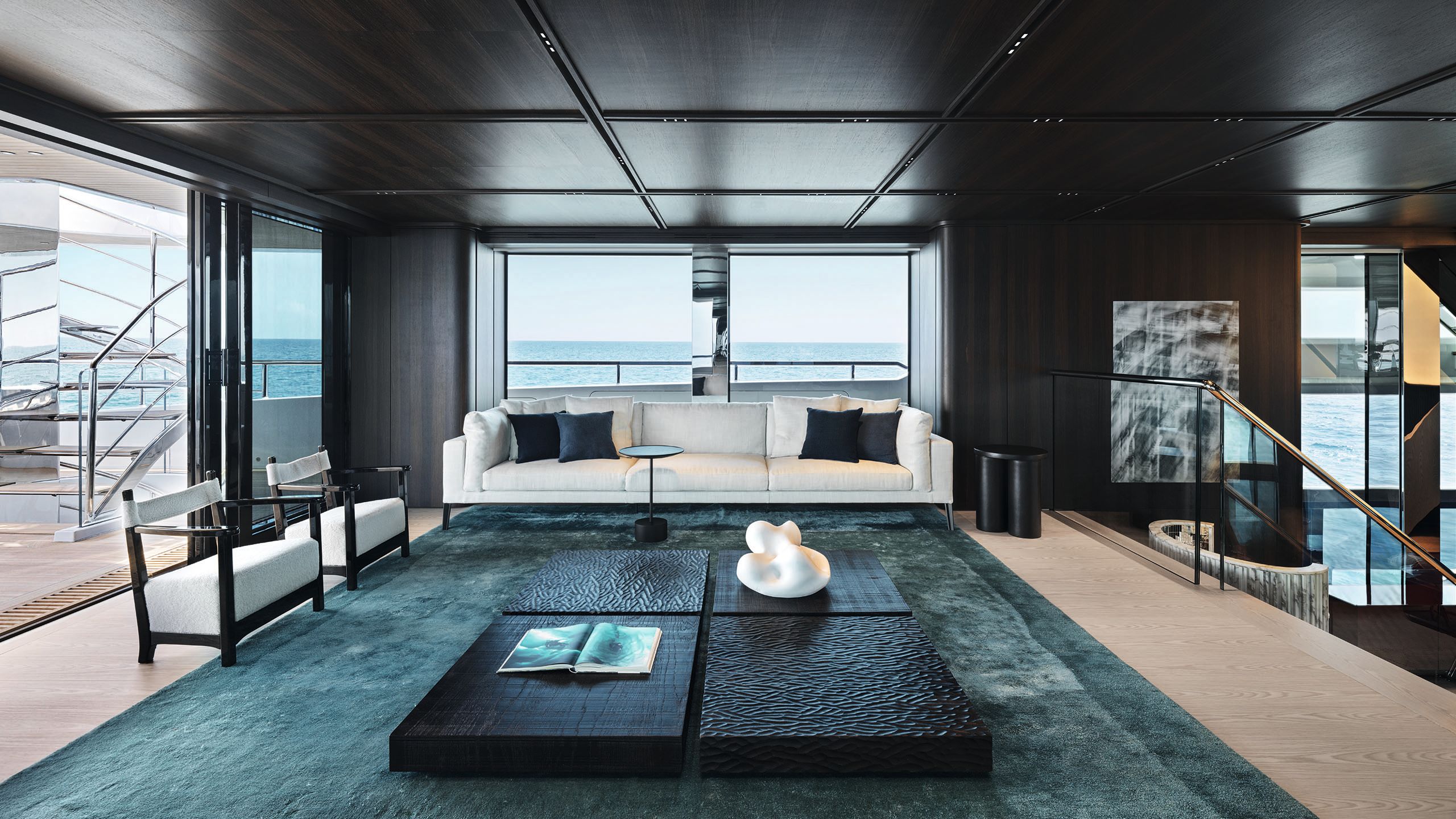

For Perotti, Almax condenses years of boat ownership into a single superyacht. When you’ve got all of your family together or you’re entertaining big groups, you’re always schlepping between decks trying to find each other. By connecting the spaces, people can spend time differently while still being within close range of each other.
“It’s a cross between a classic Italian house and a purity that is almost Japanese”
Crucially though, “from outside, you don’t have the feeling that something [about the layout] is crazy,” points out Zuccon. This is the difference between the “private” dimension inside the boat versus the “public” dimension of the exterior, an architectural concept that Zuccon embraced during the design process.
Aft, Sanlorenzo is on trend with the flat, wide open beach club complete with a little pool and unfolding bulwarks and transom. “I don’t like jacuzzis and I don’t like swimming pools,” says Zuccon firmly. “There is just one reason why you’ll find a jacuzzi or swimming pool on my projects – because I’m obliged by my clients.”
The shimmering, sparkling effect of water, though? “That is different,” he says. For a central pool up top, which bridges the gap between the split-level sundeck, the “idea was to create a sort of box in glass with water inside” that forms a focal point.
GIONATA XERRA
GIONATA XERRA
“The beautifully bizarre layout staggers and cascades to create nooks and unexpected open areas”
For the interiors, Lissoni also revisited the styling of Perotti’s former SP110 and cranked things up a couple of notches. “Each boat is an evolution of the previous one – although I try to forget almost everything I learned from the previous models in order to add new experiences to the design,” says Piero Lissoni.
Maybe it’s the vintage-style sheepskin chairs or the tiled bathrooms in shades of muted seafoam and pear green, but the whole vibe feels distinctly retro, with just a touch of that too-cool Sanlorenzo elegance that the builder nails so peerlessly.
GIONATA XERRA
GIONATA XERRA
GIONATA XERRA
GIONATA XERRA
GIONATA XERRA
GIONATA XERRA
GIONATA XERRA
GIONATA XERRA
GIONATA XERRA
GIONATA XERRA
GIONATA XERRA
GIONATA XERRA
In the owner’s cabin, a Japanese silk folding screen stretches across the wall aft, with a hand-painted depiction of cranes (top left, bottom right)
Touches of cinnamon red ribbed wood panelling and circular portholes feature in the guest cabins, while in the dining saloon there’s an old-school bar with fluted glass that would look at home in an art deco New York hotel.
The whole vibe feels distinctly retro, with just a touch of that too-cool Sanlorenzo elegance that the builder nails so peerlessly
“I used materials that are in some way unusual in the nautical world, such as the tiles in the bathrooms, the mahogany… it’s a cross between a classic Italian house and a purity that’s almost Japanese,” Lissoni says. “Normally I use colour very delicately,” but on Almax, he admits he was bolder with his choice of hues. I suppose bolder colours make sense for a bolder boat.
GIONATA XERRA
GIONATA XERRA
GIONATA XERRA
GIONATA XERRA
GIONATA XERRA
GIONATA XERRA
GIONATA XERRA
GIONATA XERRA
Italian ceramicist Domenico Mori created the unusual tiles in the en suites of all the cabins (bottom left); there are also spa facilities, including a hammam (top right)
At the window of Perotti’s office, he takes out his iPhone and snaps a picture of the yacht. When Steve Jobs released the first iPhone to the world in 2007, it had 4GB of storage, a two-megapixel camera and a loud convoy of critics. Fast forward to 2024, the latest model holds up to 1TB of storage, a 48-megapixel camera and a slick design that has made it the dominant smartphone in today’s market.
It was a phone of firsts, and naturally left space for improvements. Perotti might call it a slice of salami, but to me, the 50Steel reminds me of the first iPhone. Next stop, market domination.
First published in the October 2024 issue of BOAT International. Get this magazine sent straight to your door, or subscribe and never miss an issue.
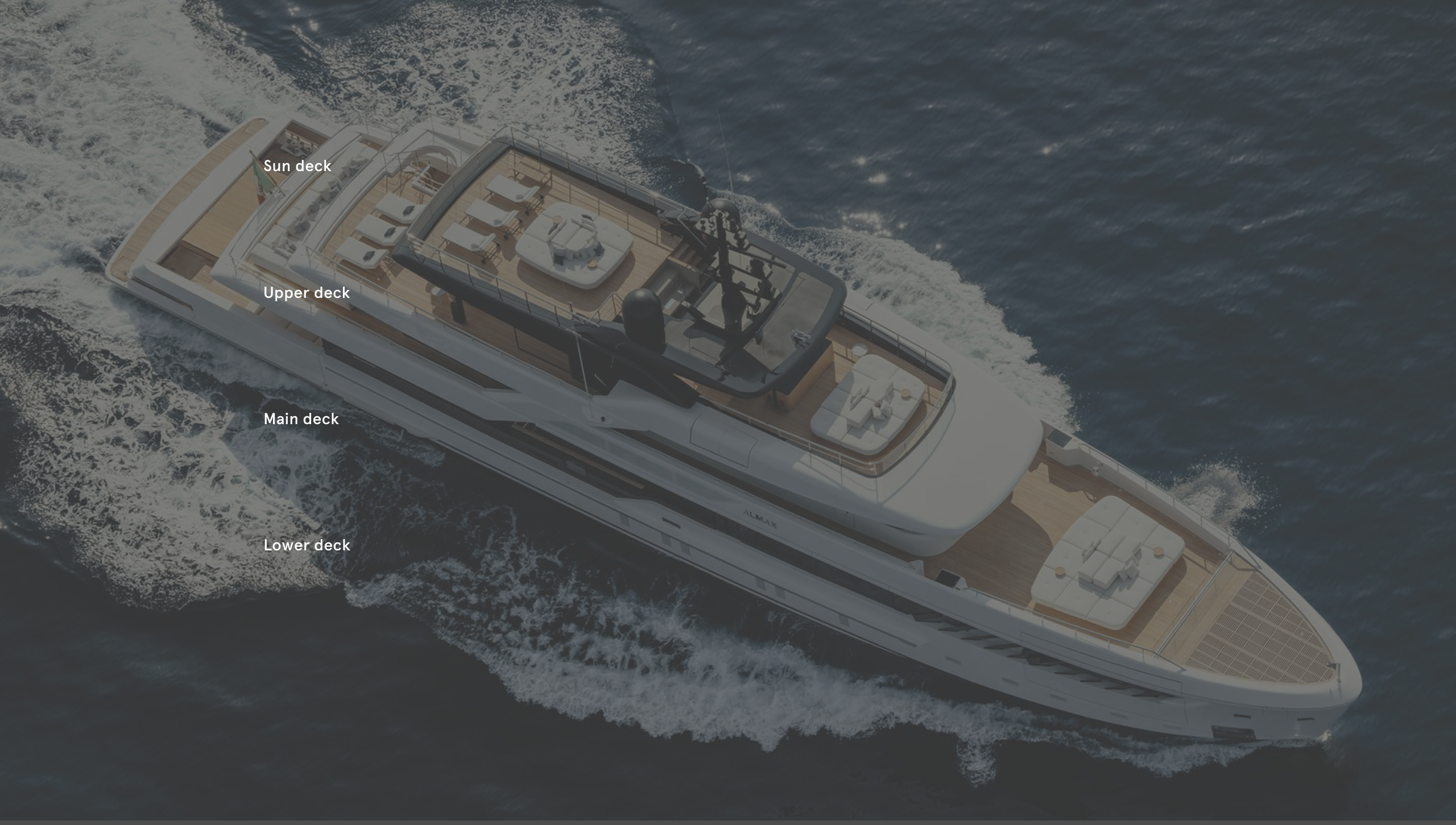
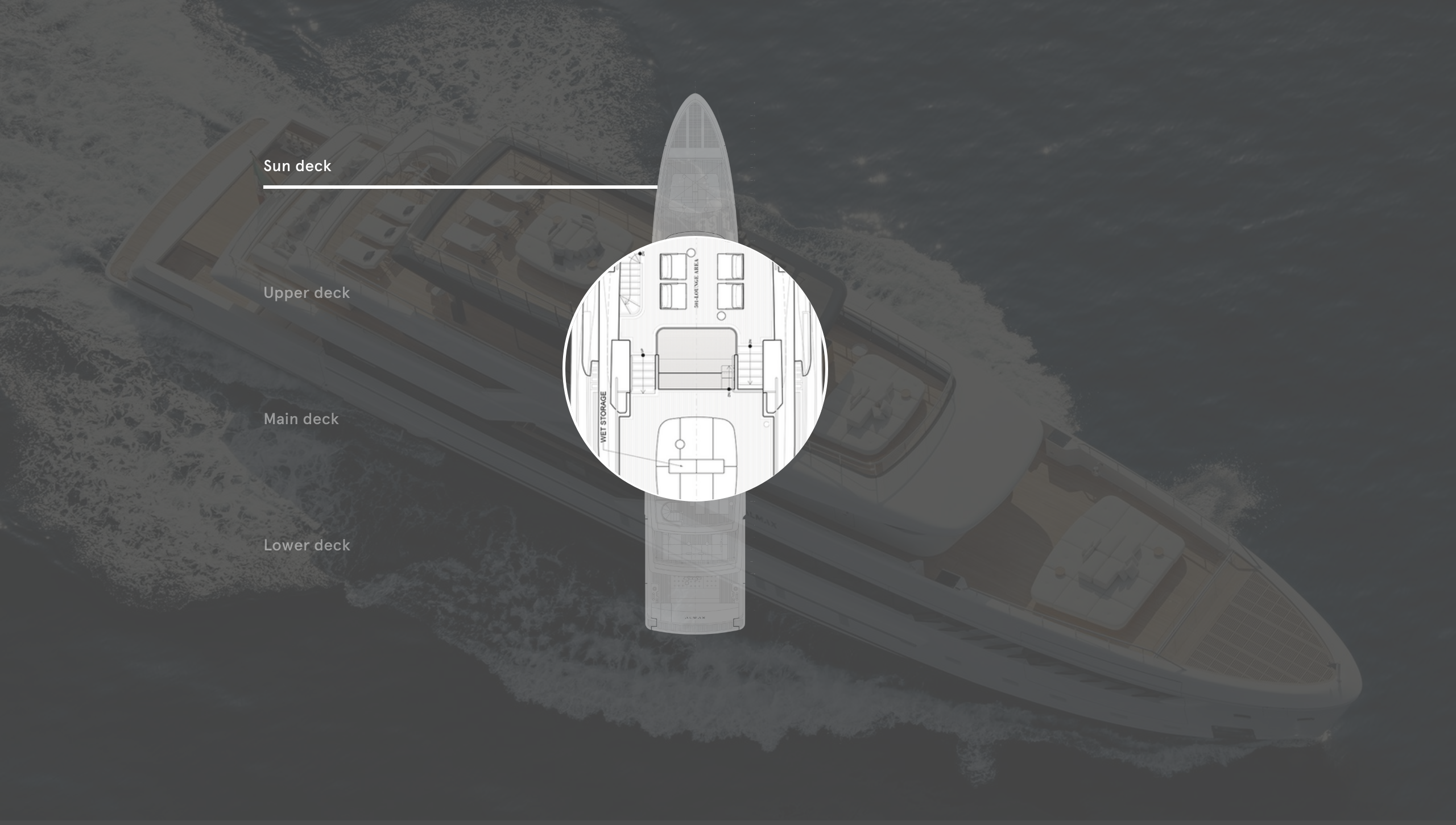
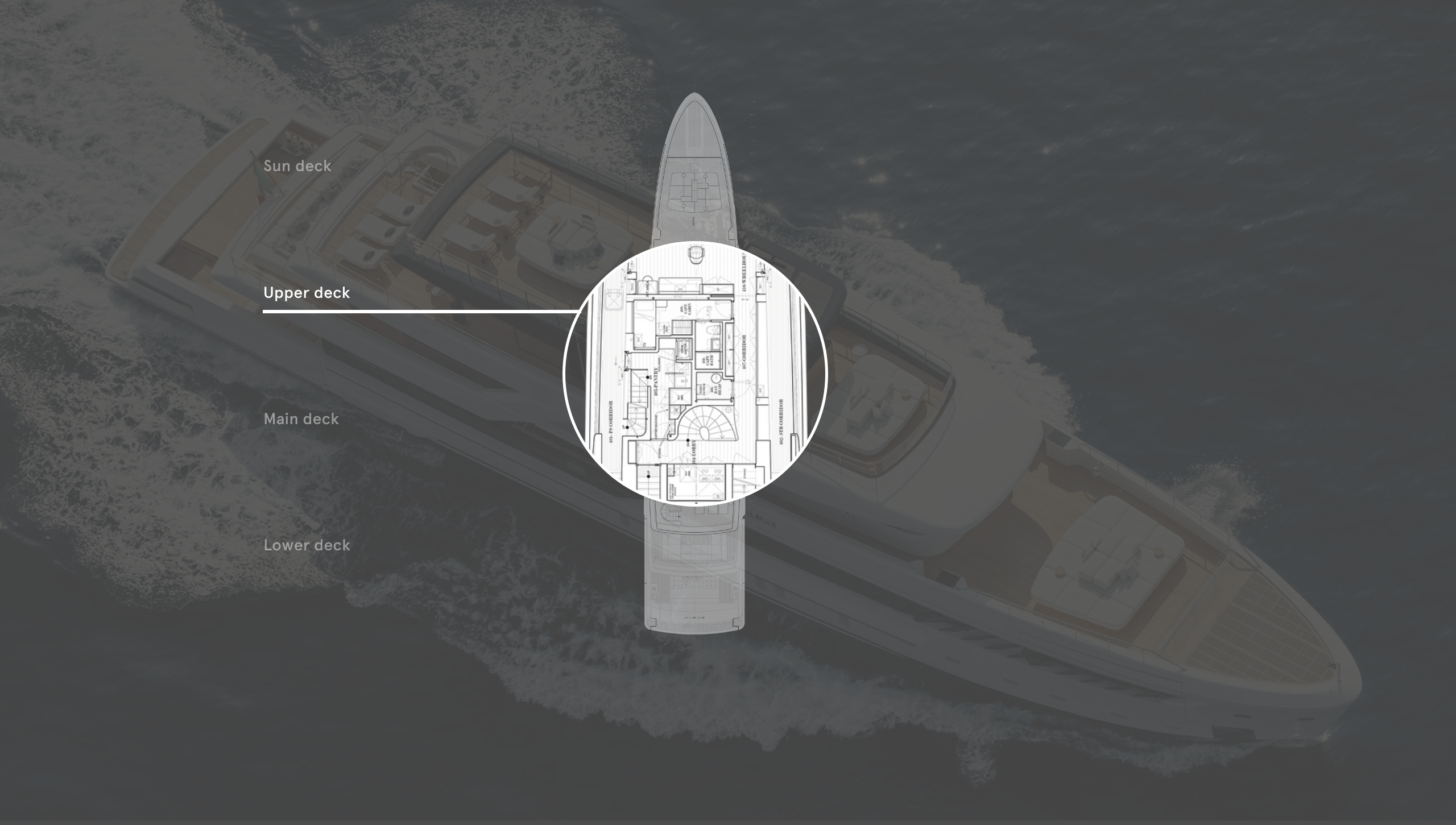
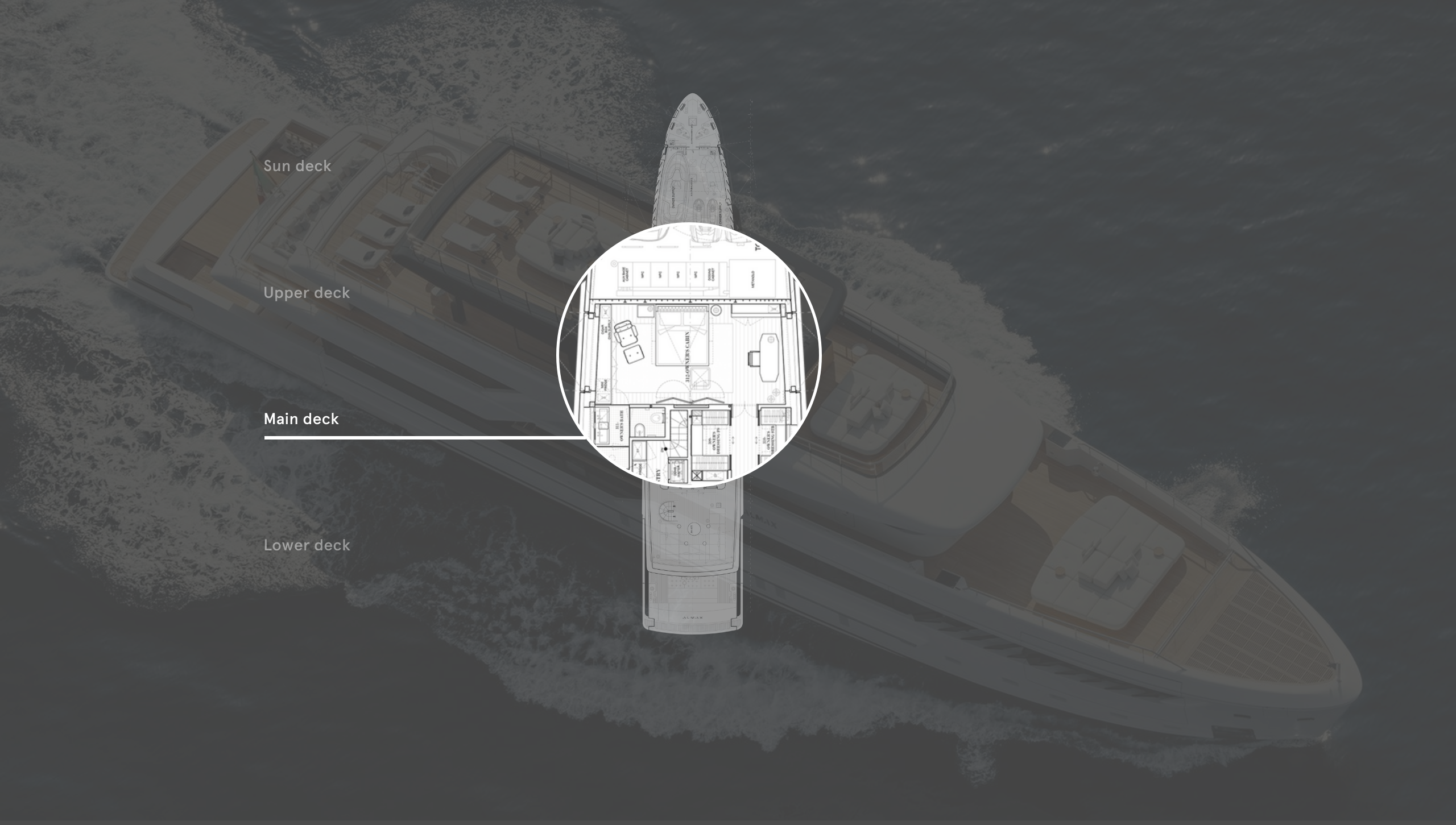
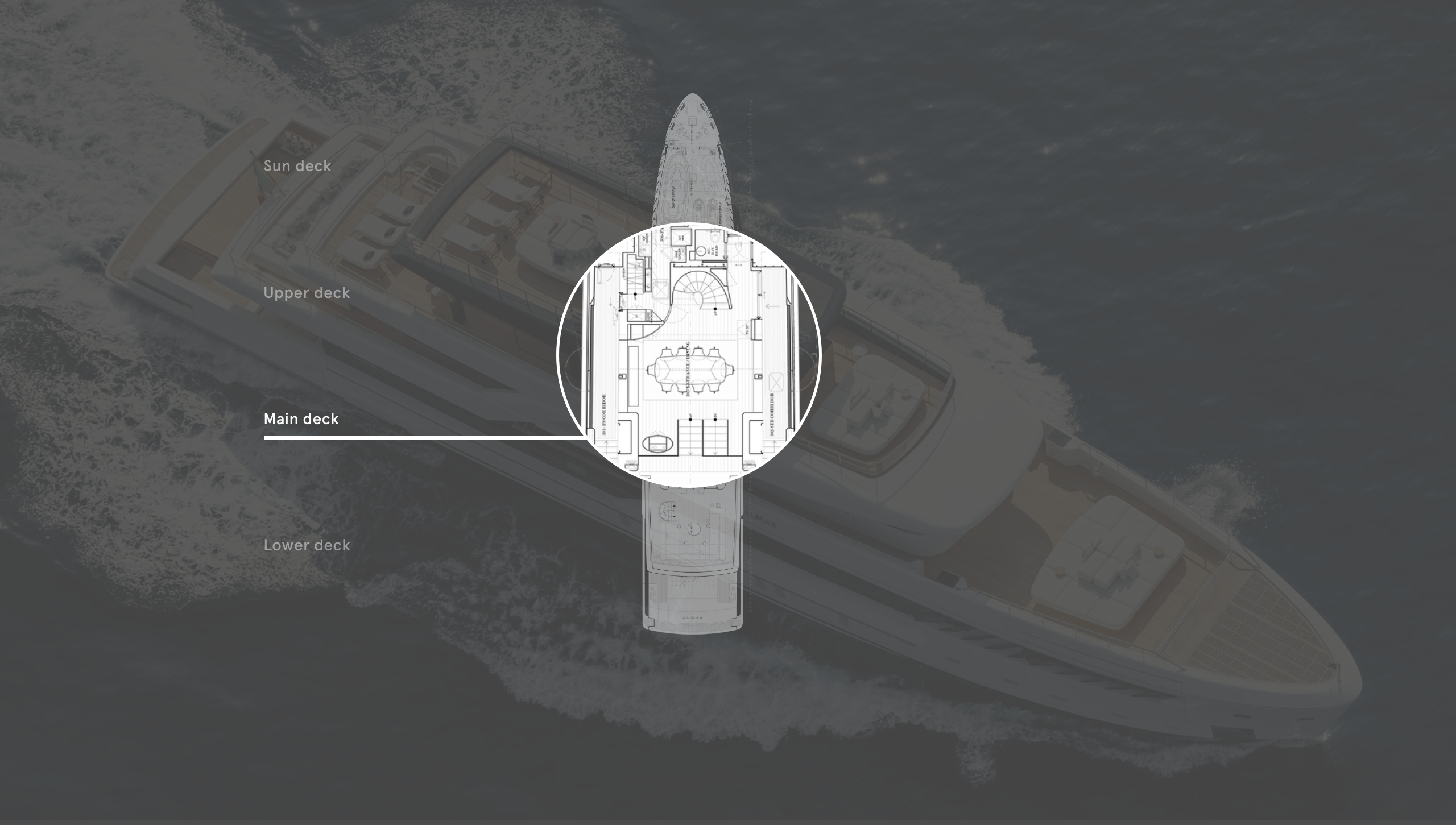
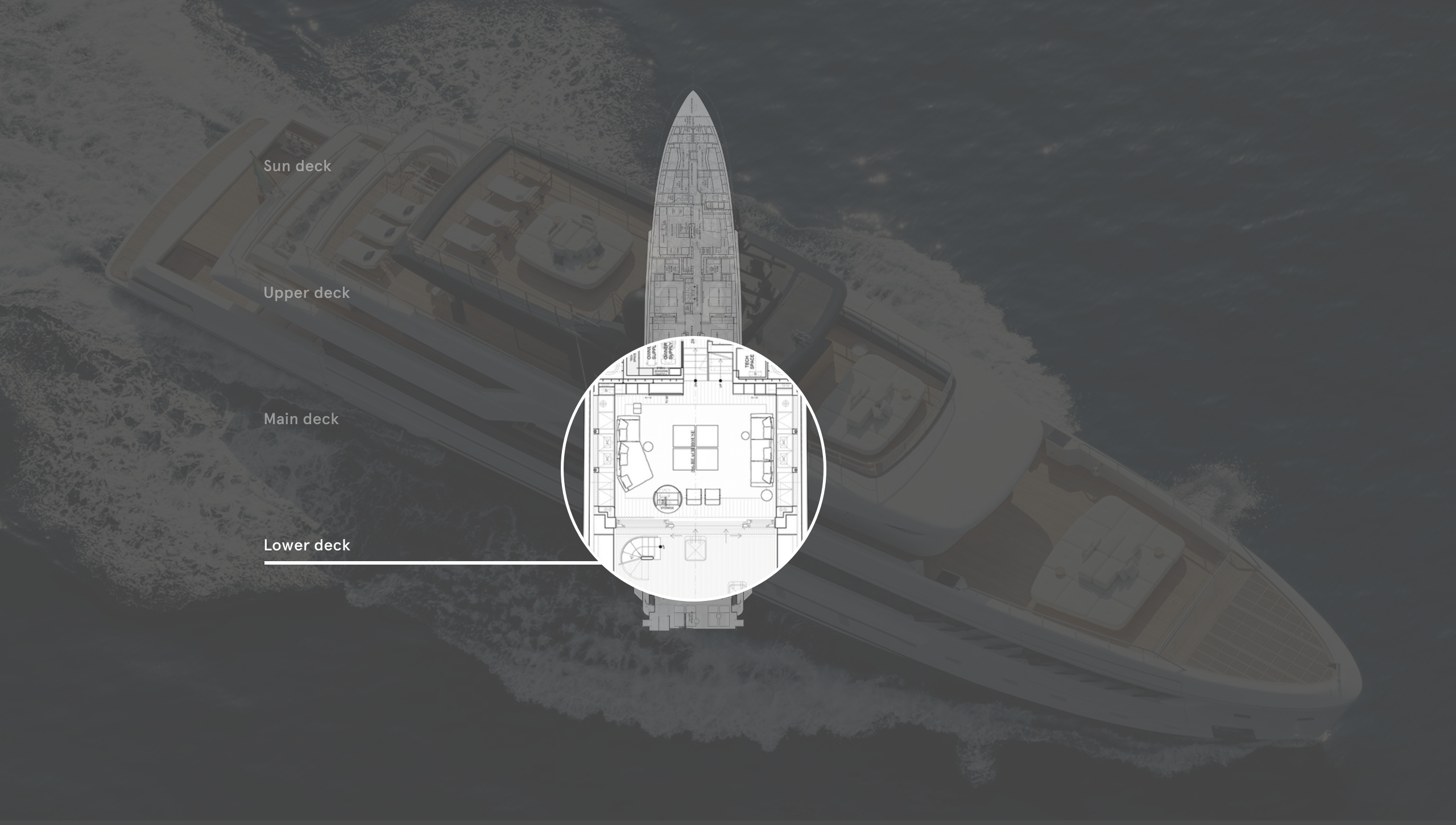

A pool connects the sundeck’s two levels
A dumb waiter from the lower deck and large pantries aid in service
The owner’s cabin includes space for a desk with a view
Windows of almost four metres tall flank the dining table
With the engine room hidden on the tank deck, there’s space for a lower- deck saloon
LOA 49.99m | Gross tonnage |
LWL 46.73m | Engines |
Beam 9.4m | Generators |
Draught 2.96m | Speed (max/cruise) |
Range at 11 knots | Owners/guests 10 |
Fuel capacity | Crew 9 |
Freshwater capacity | Construction |
Tender | Naval architecture |
Exterior design | Builder/year |
Interior design | For charter |


